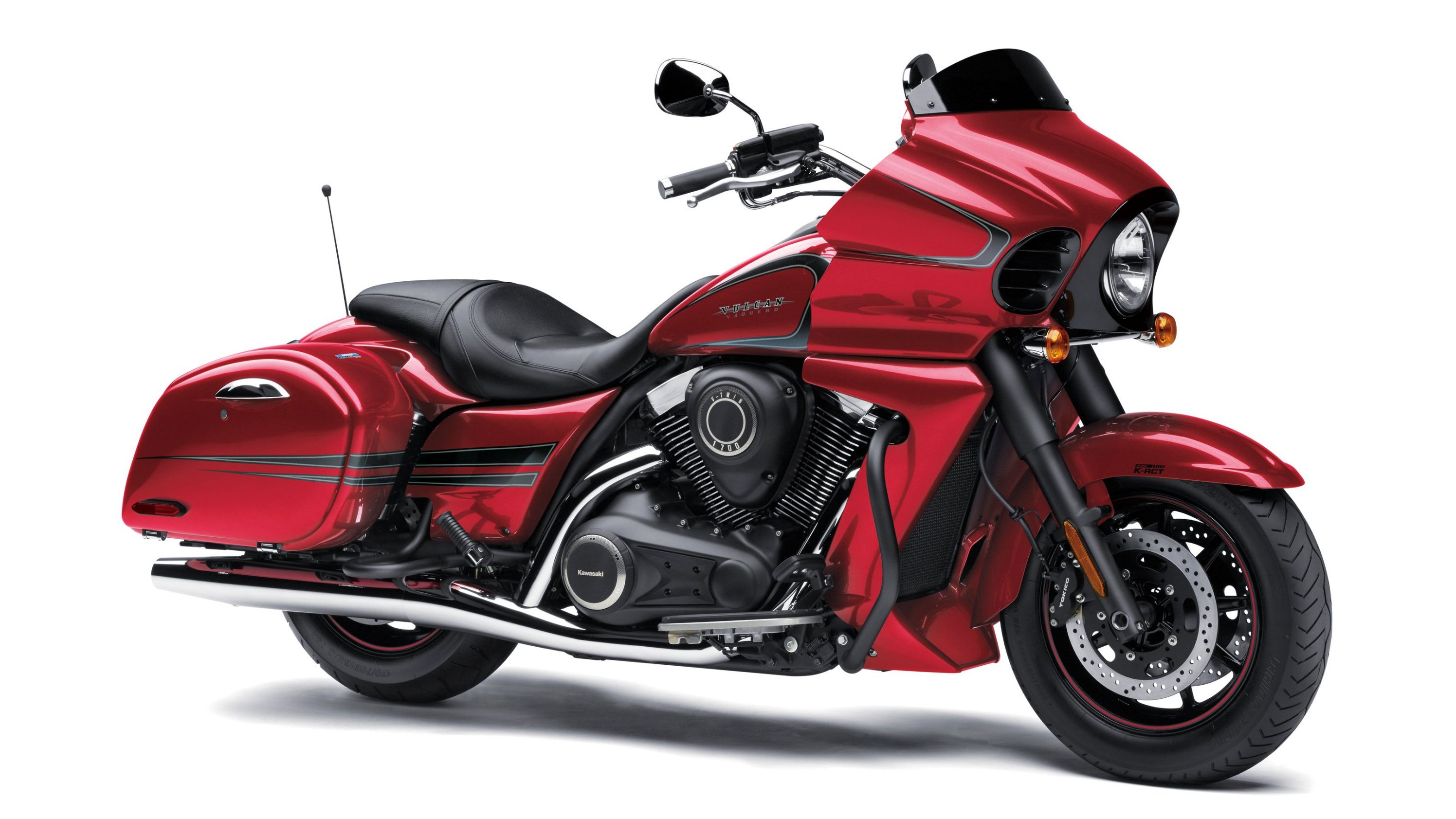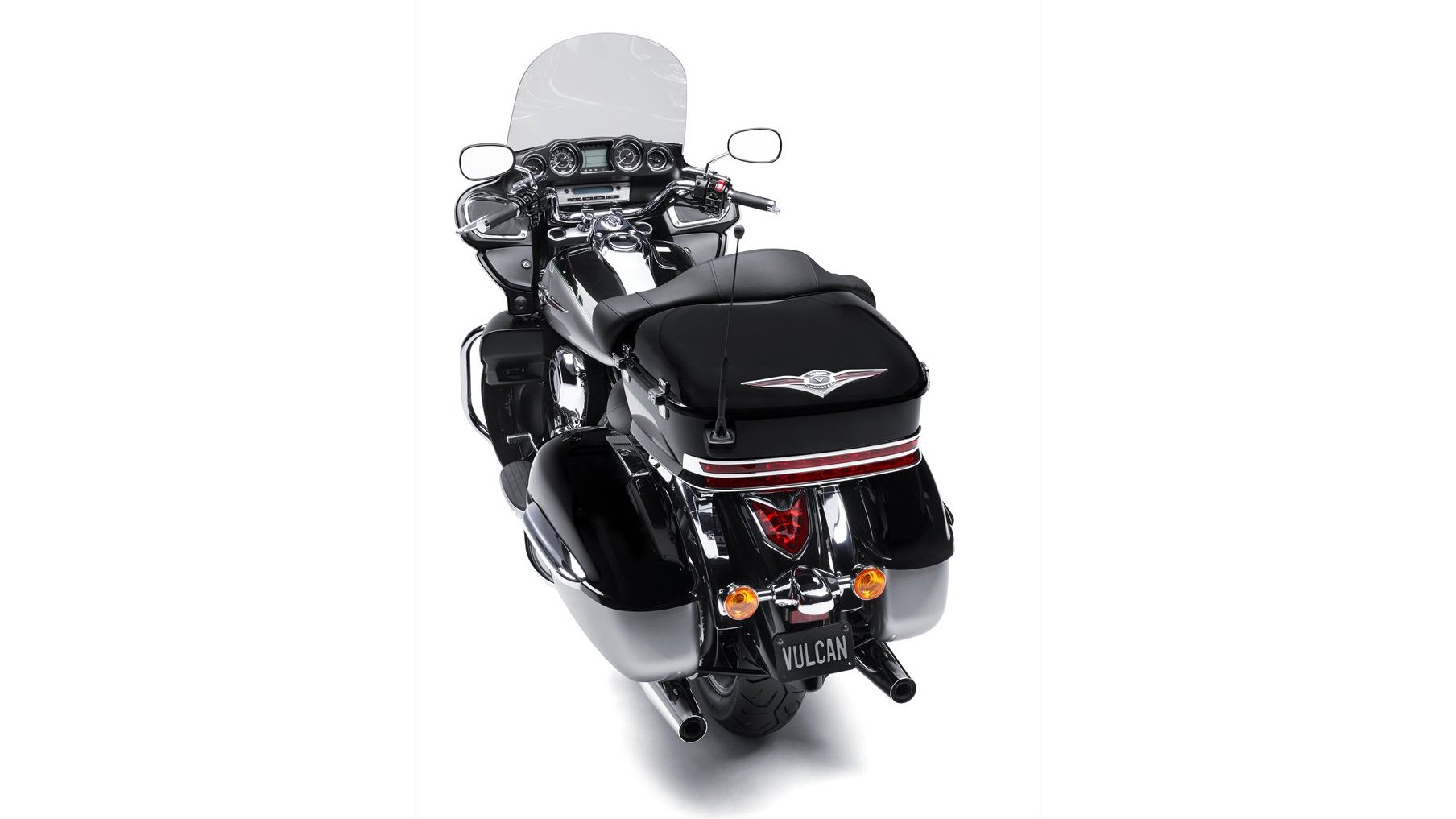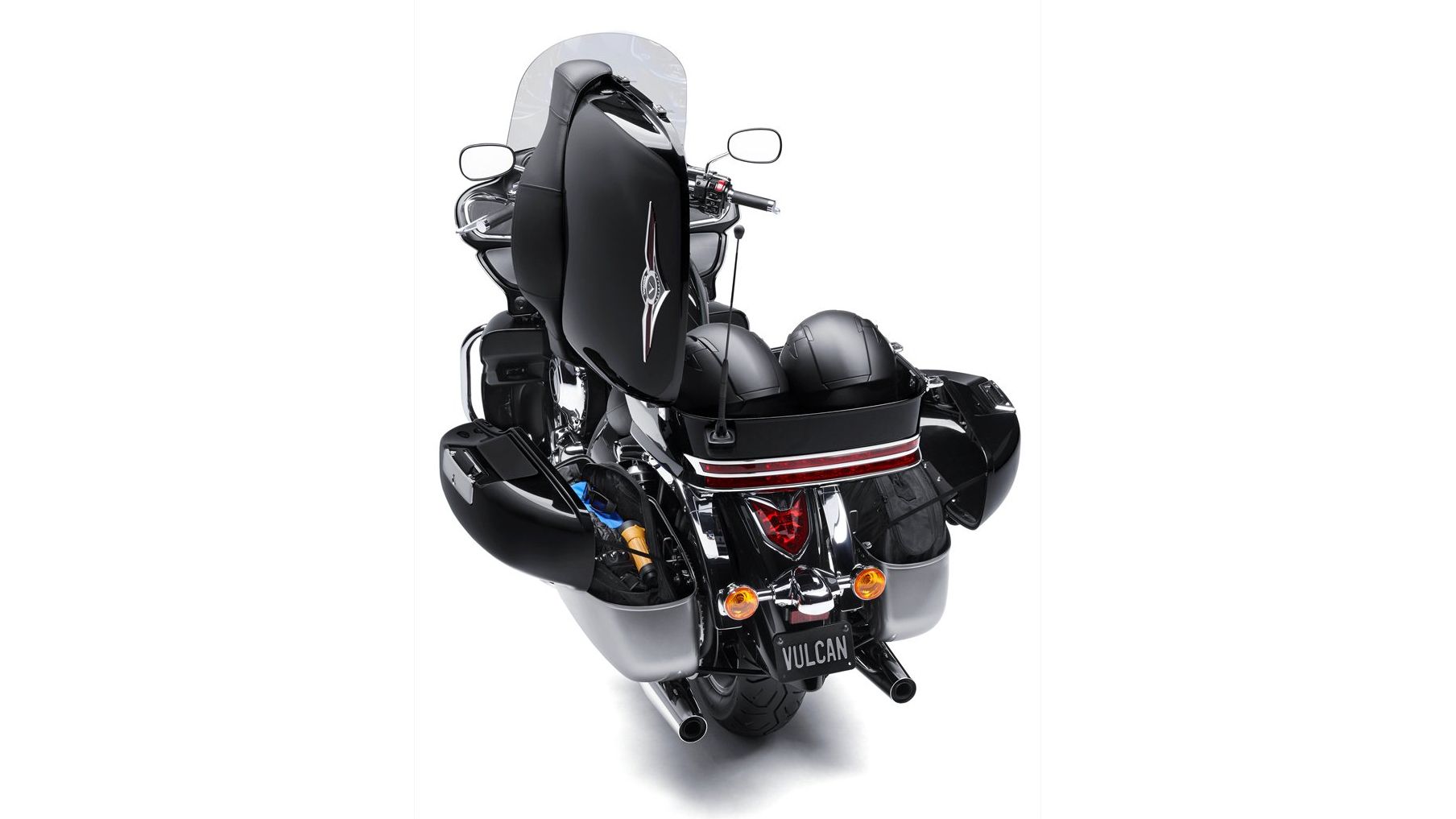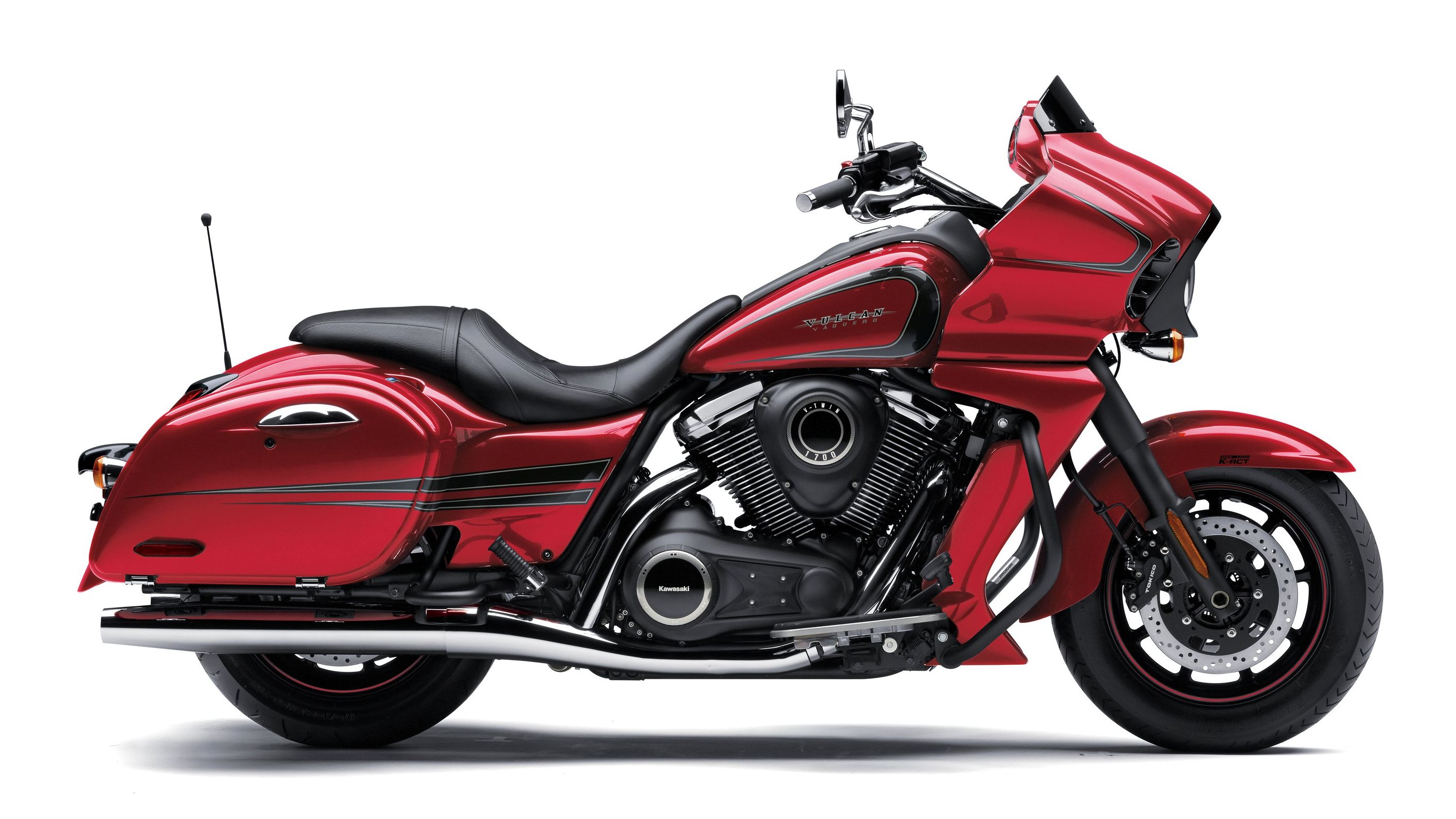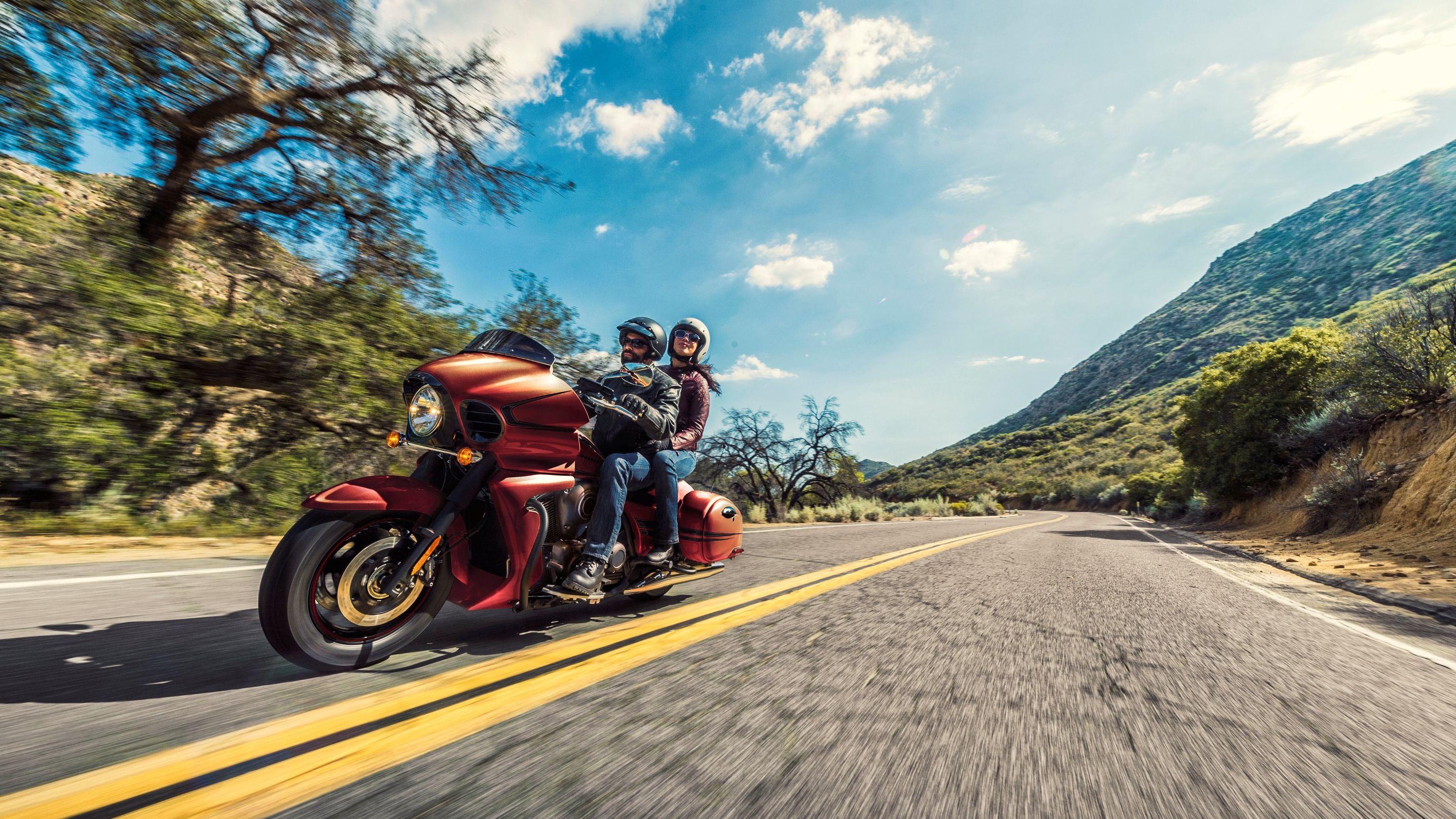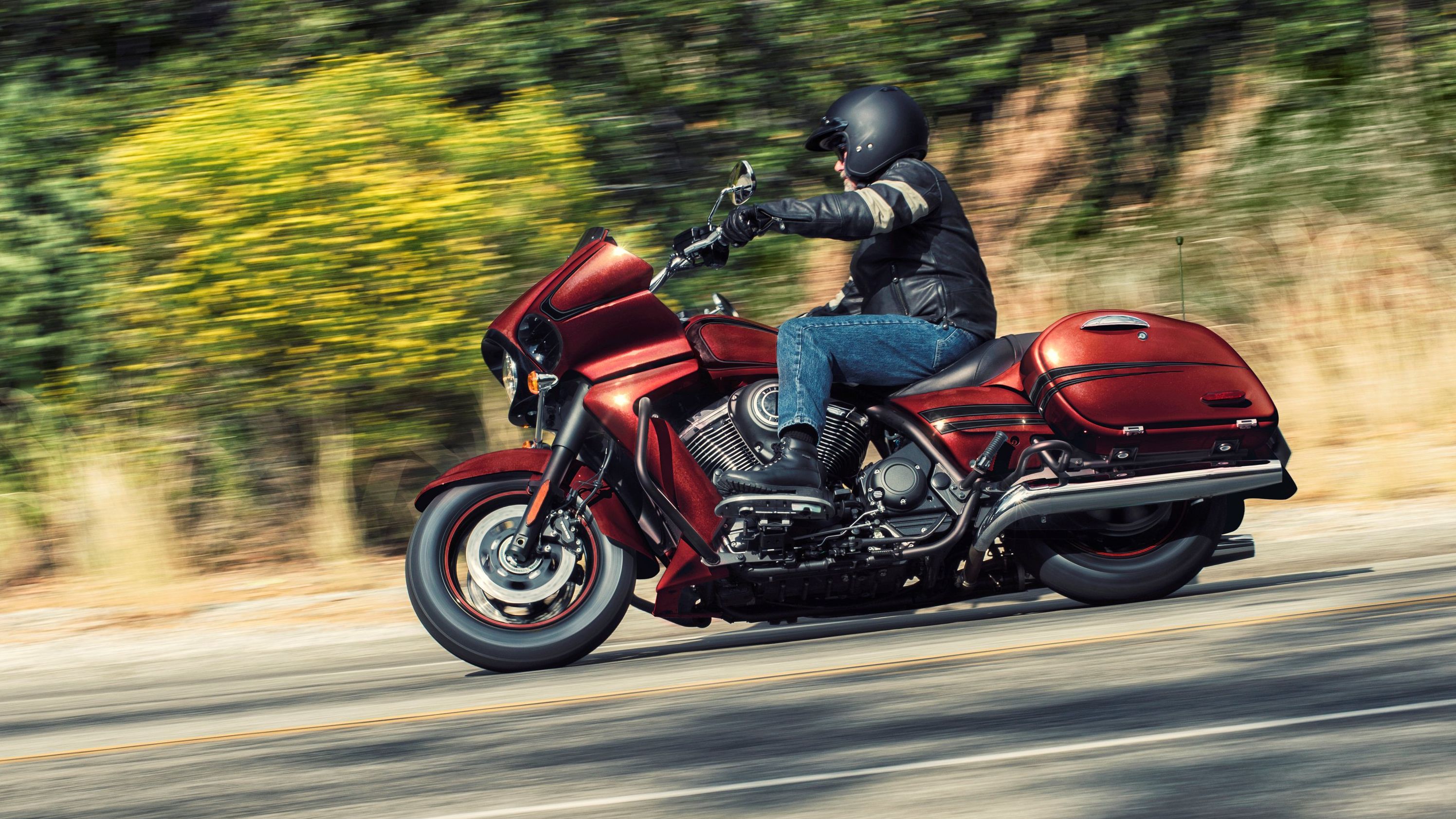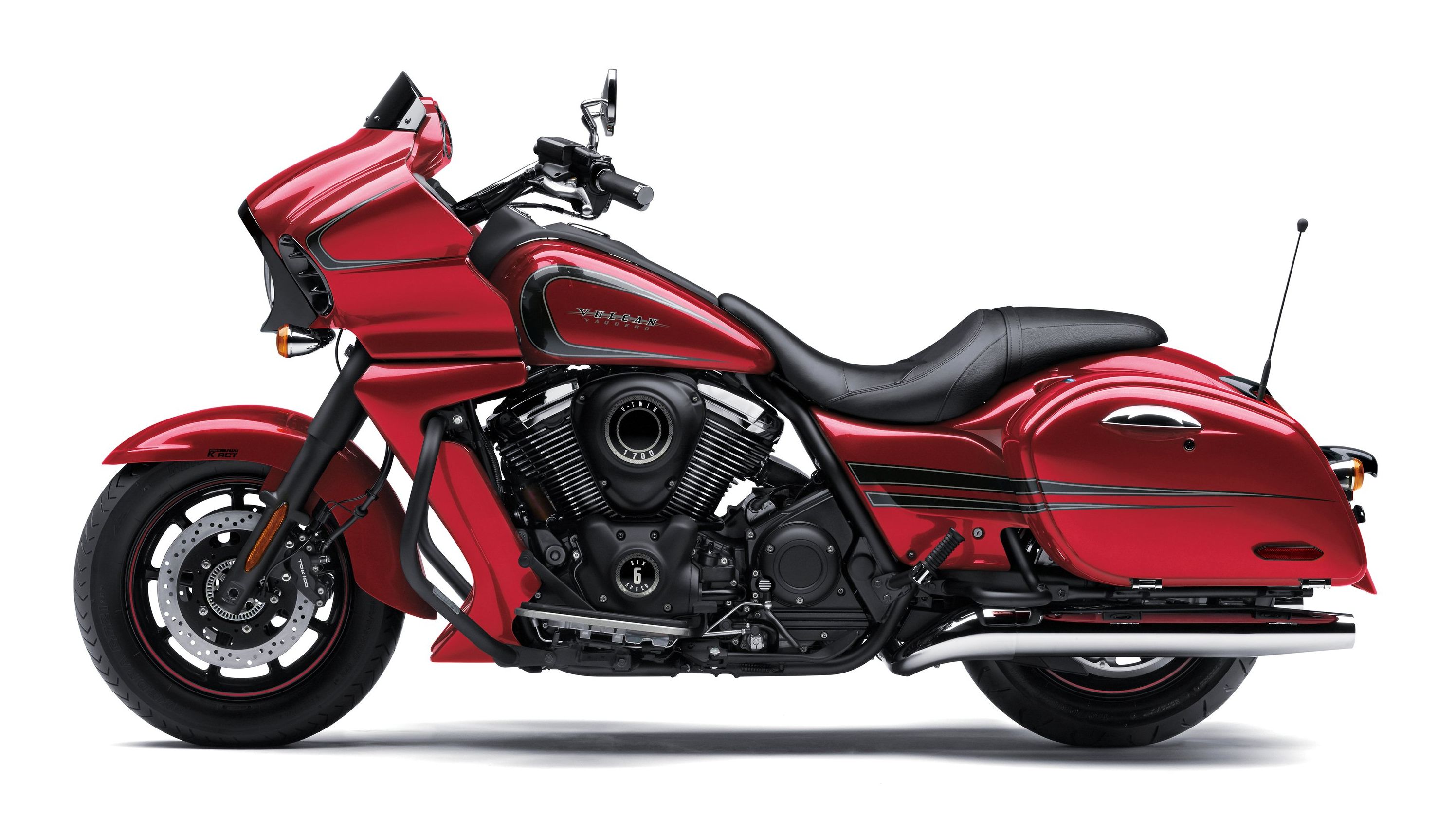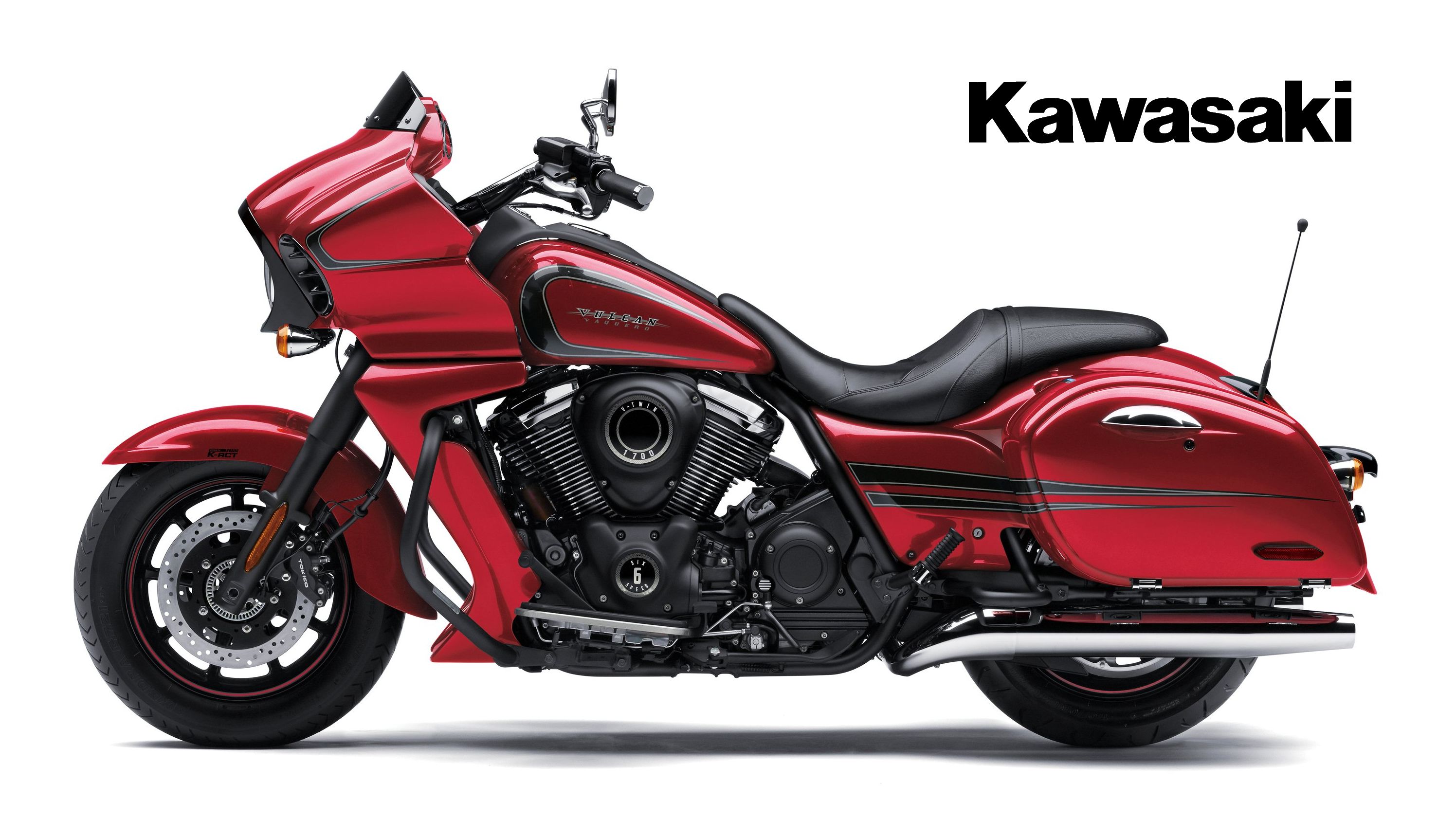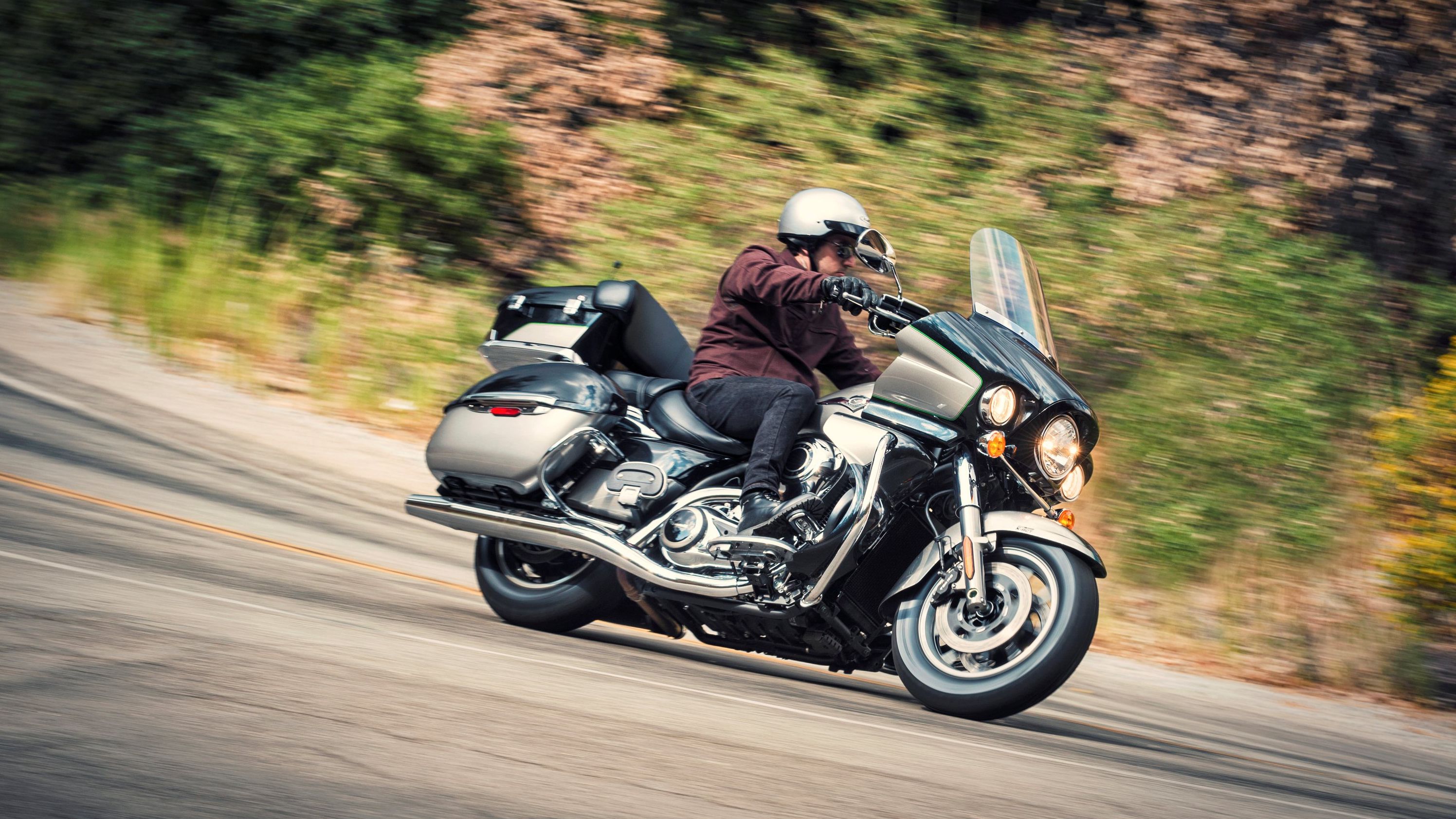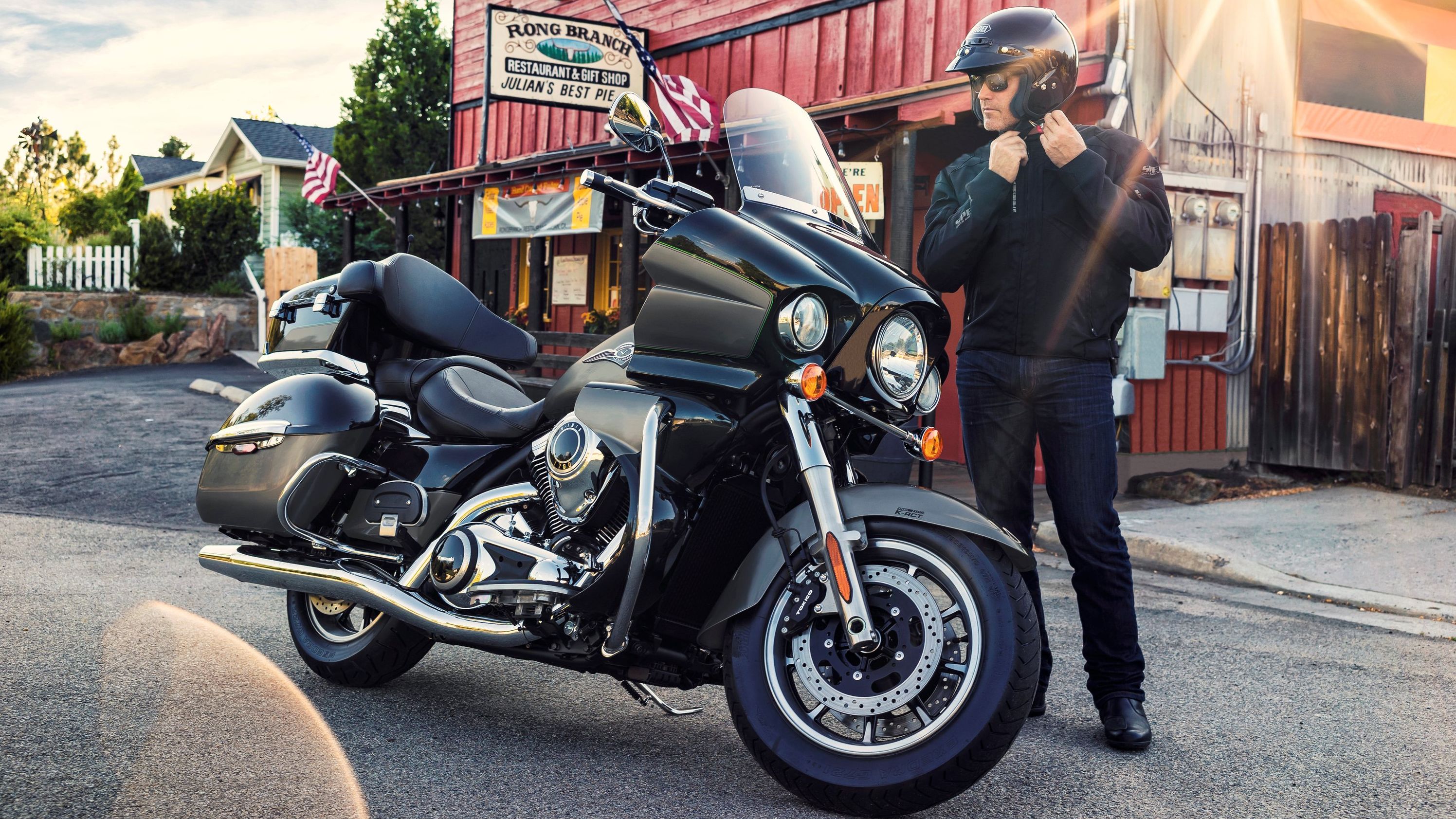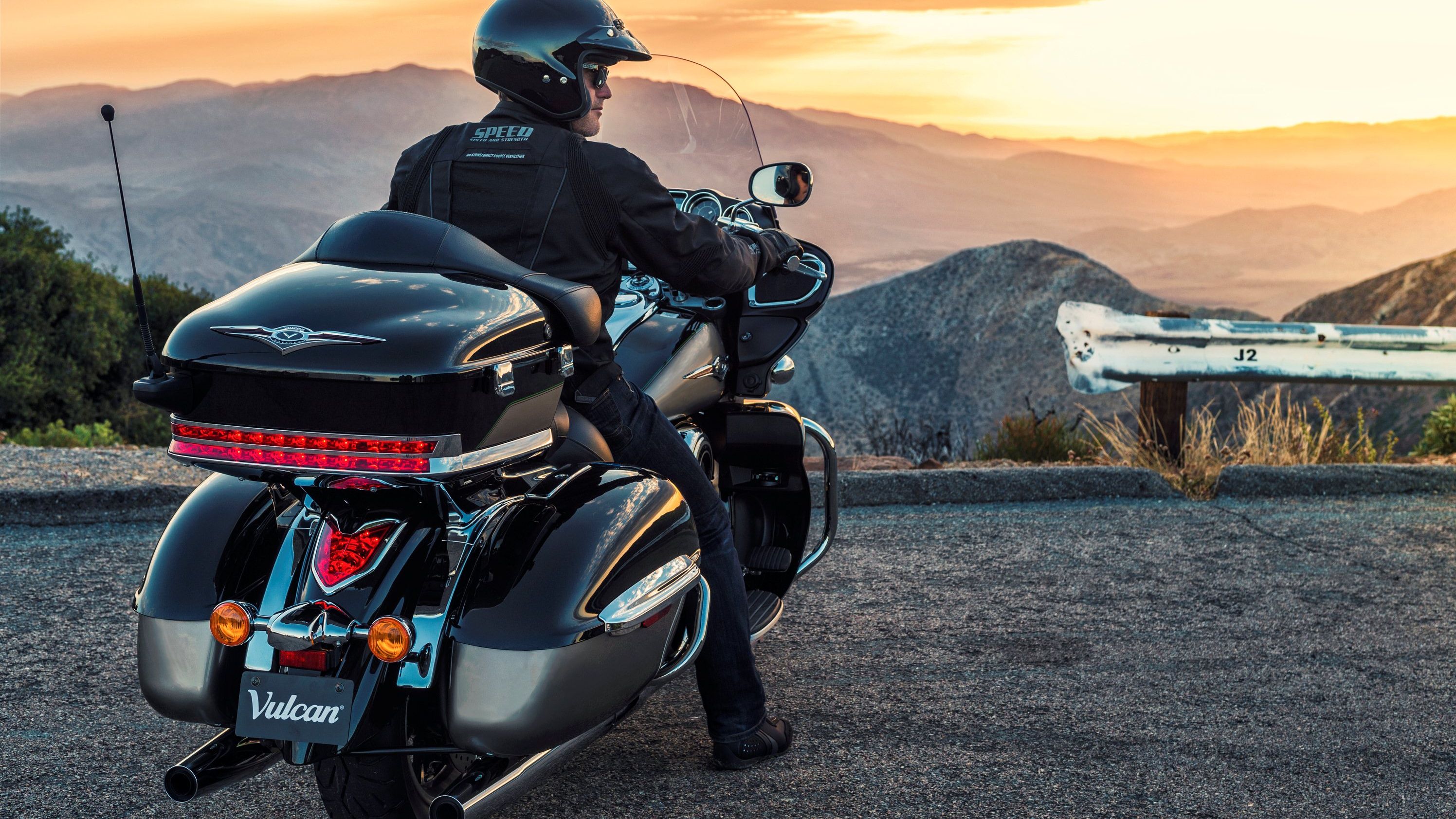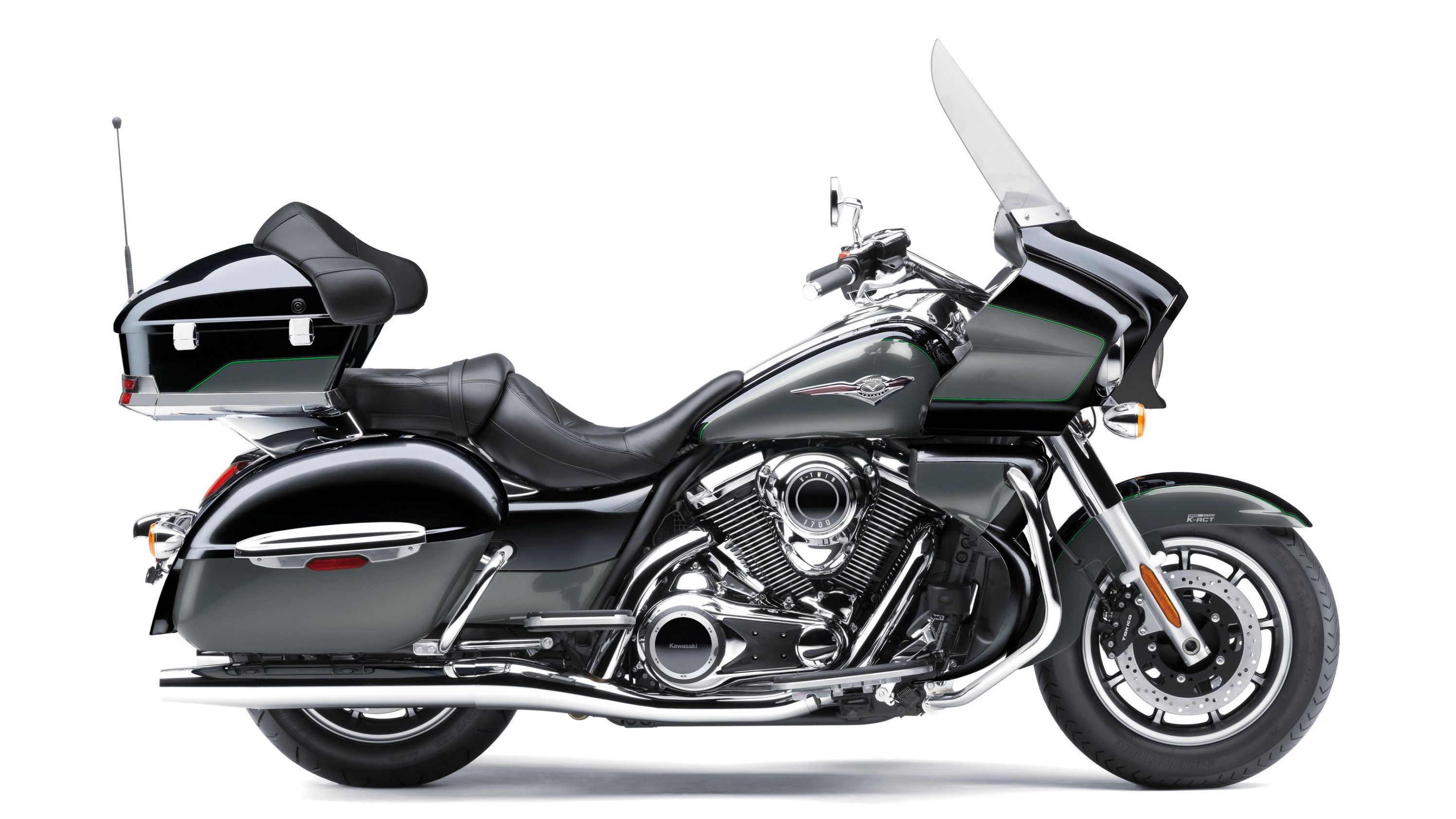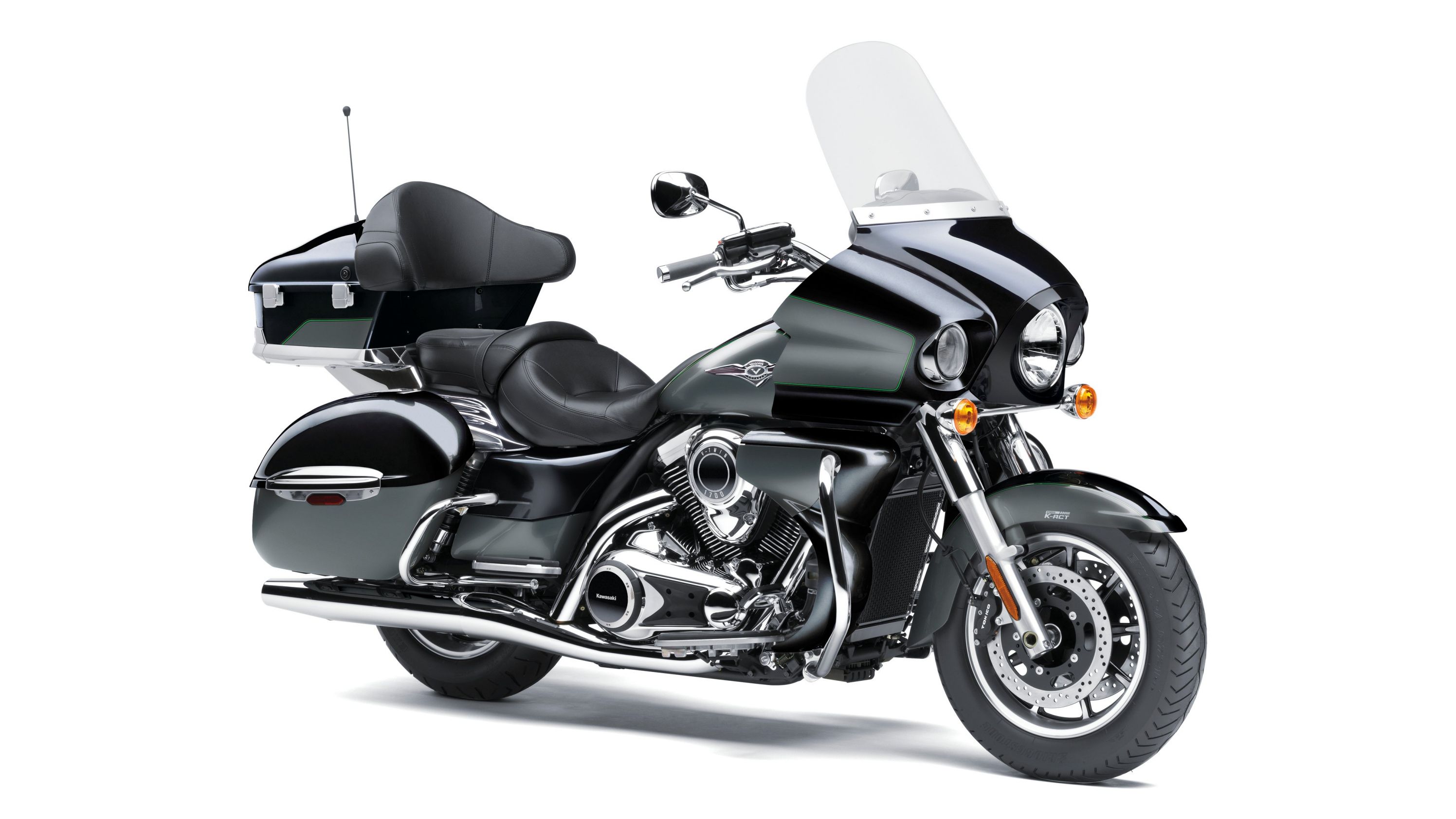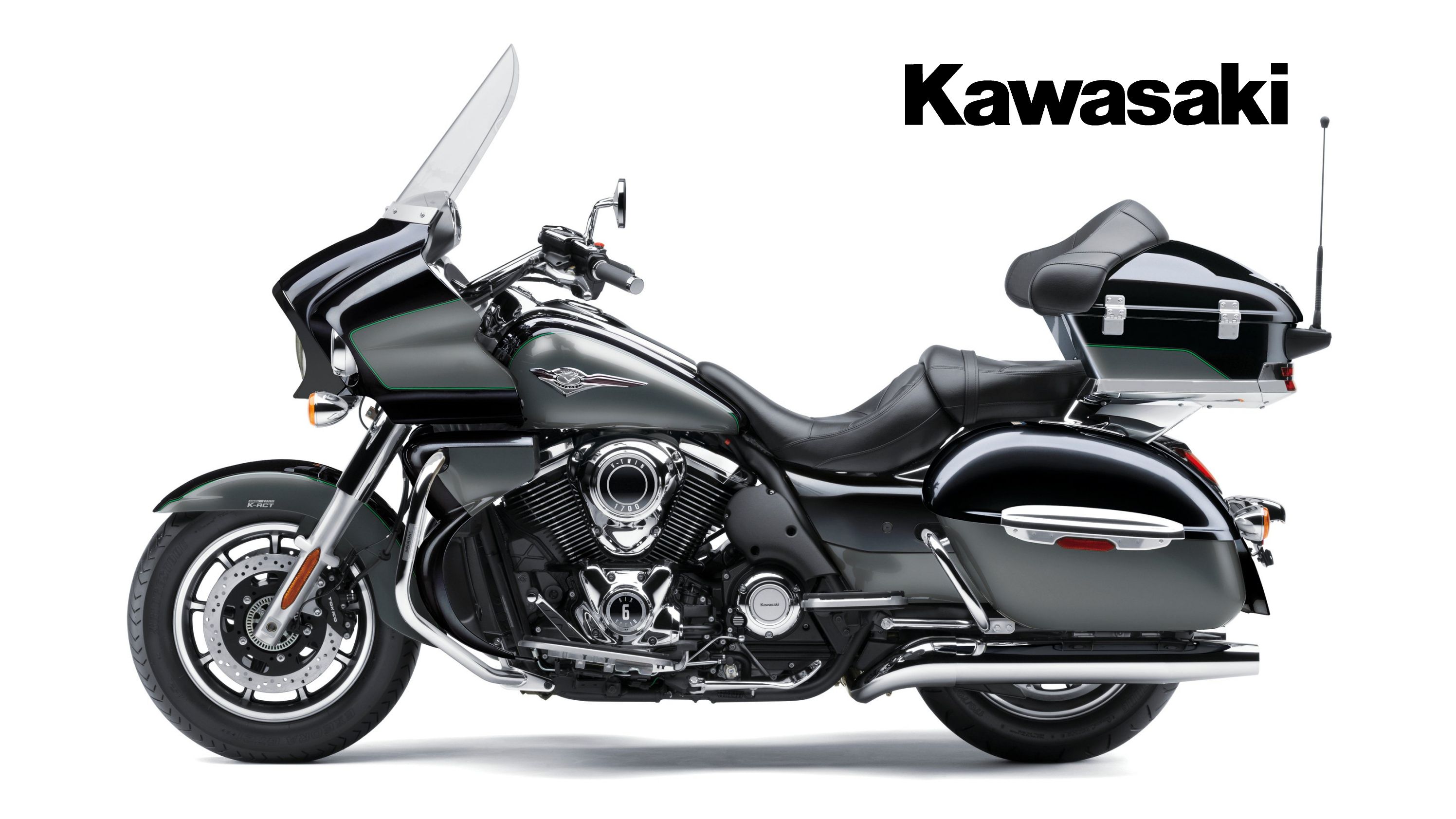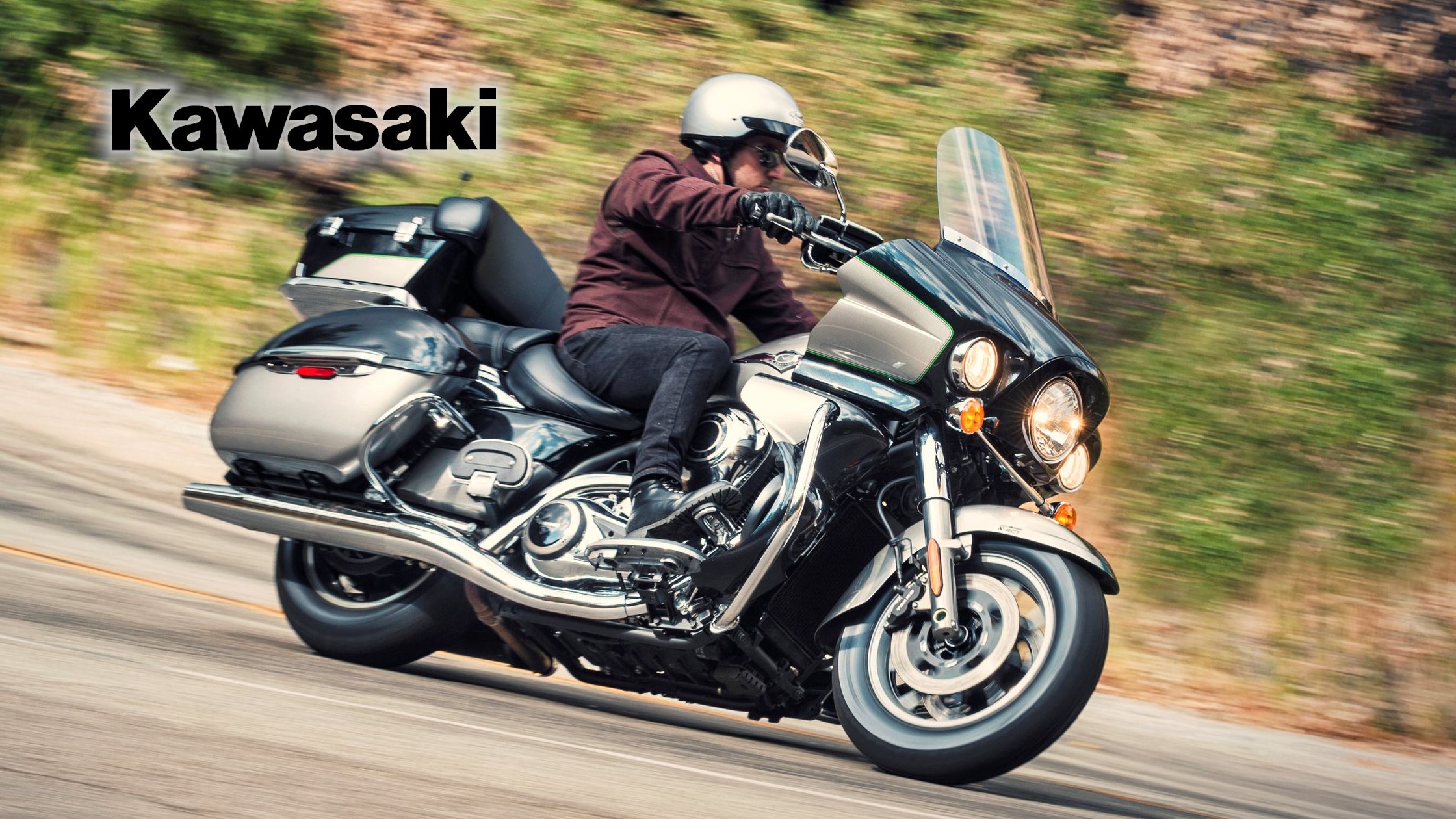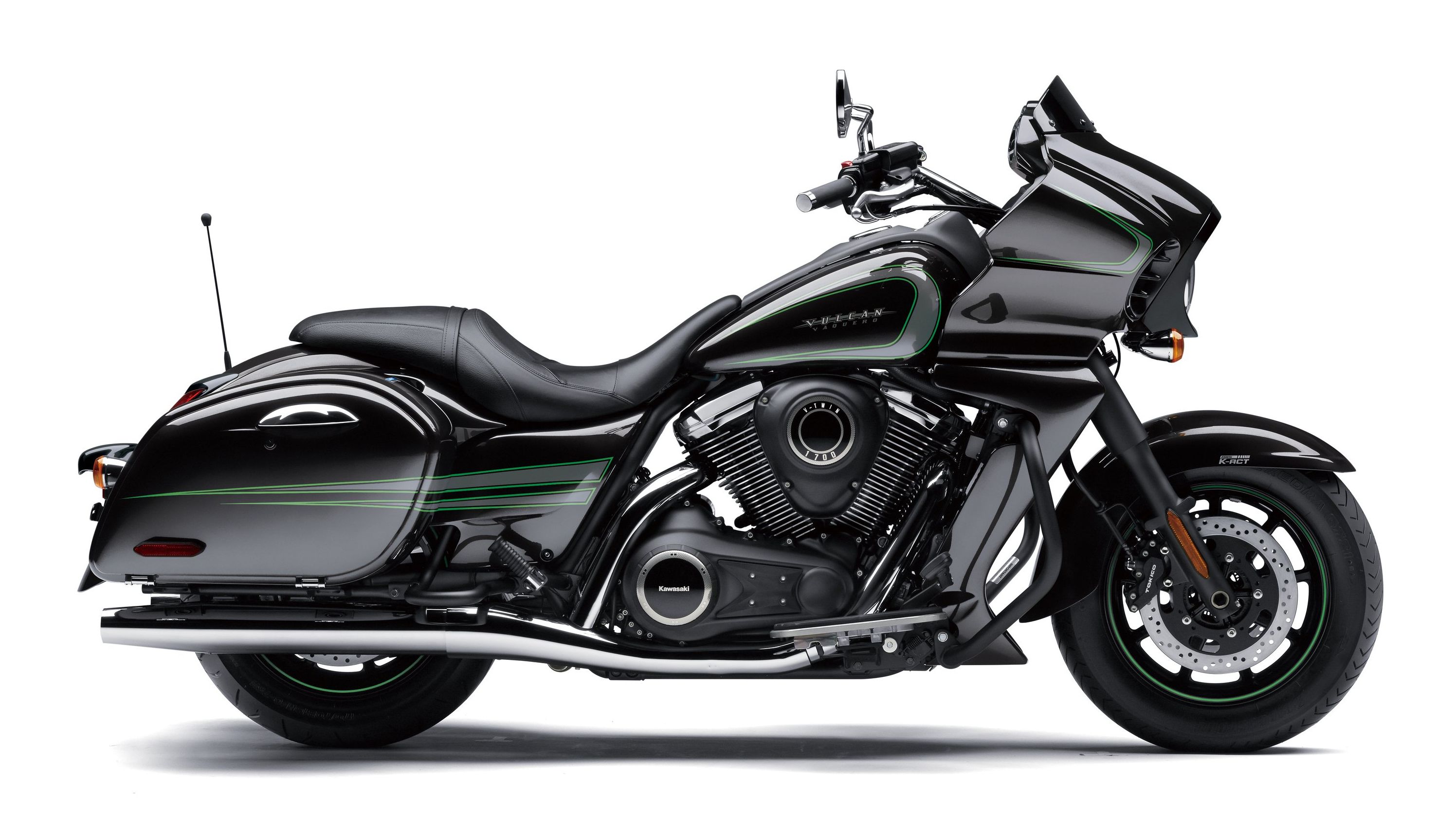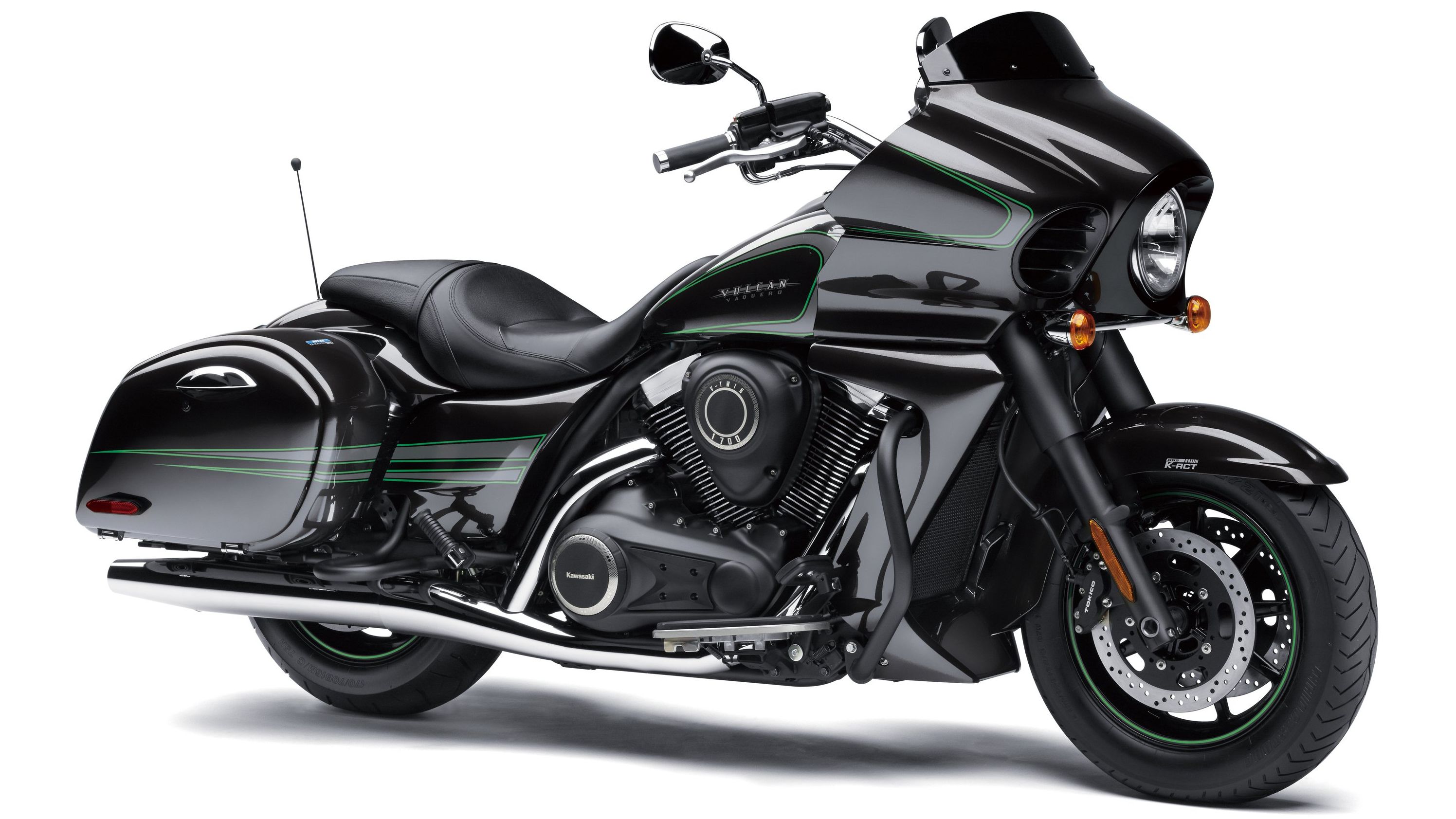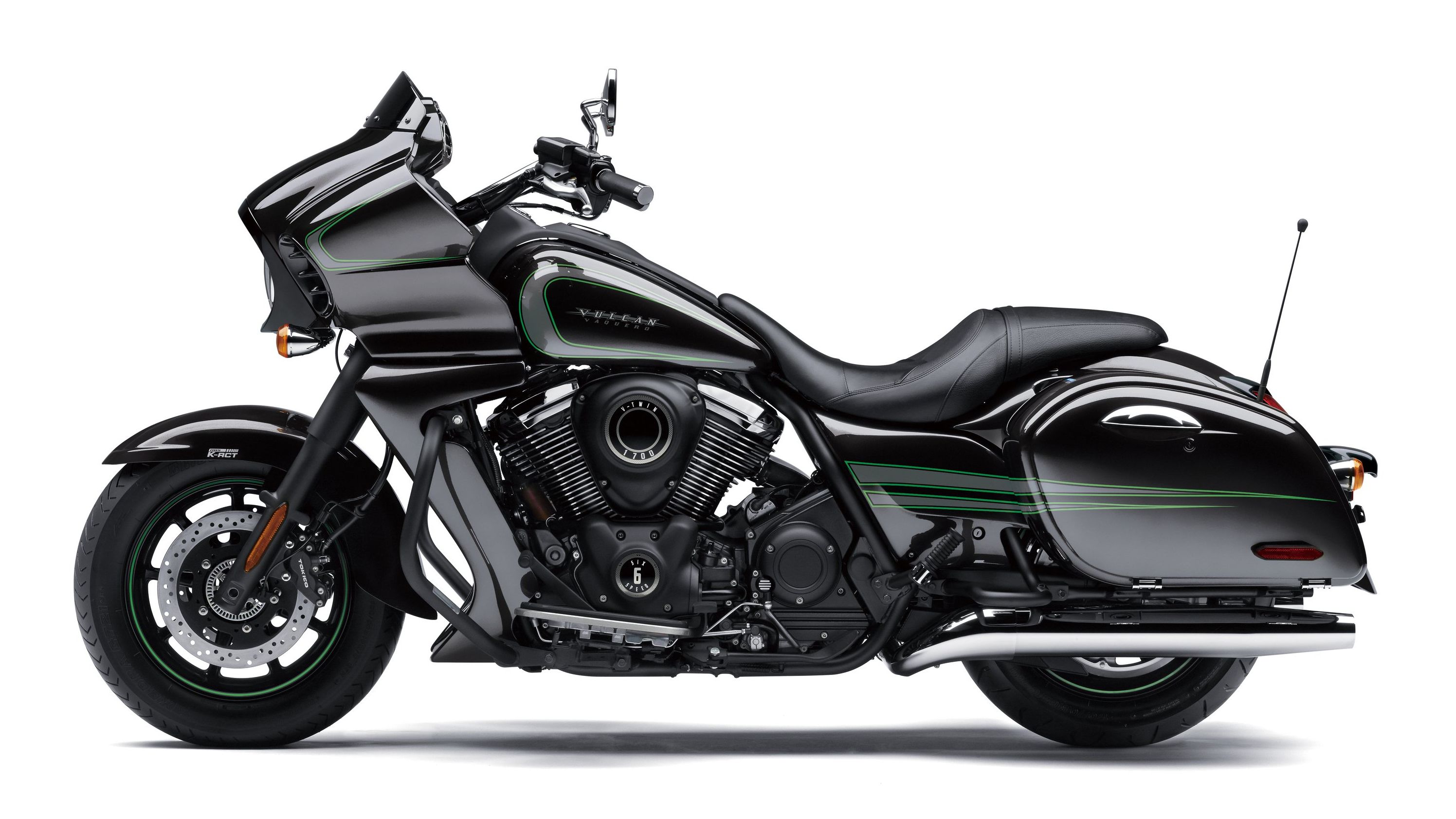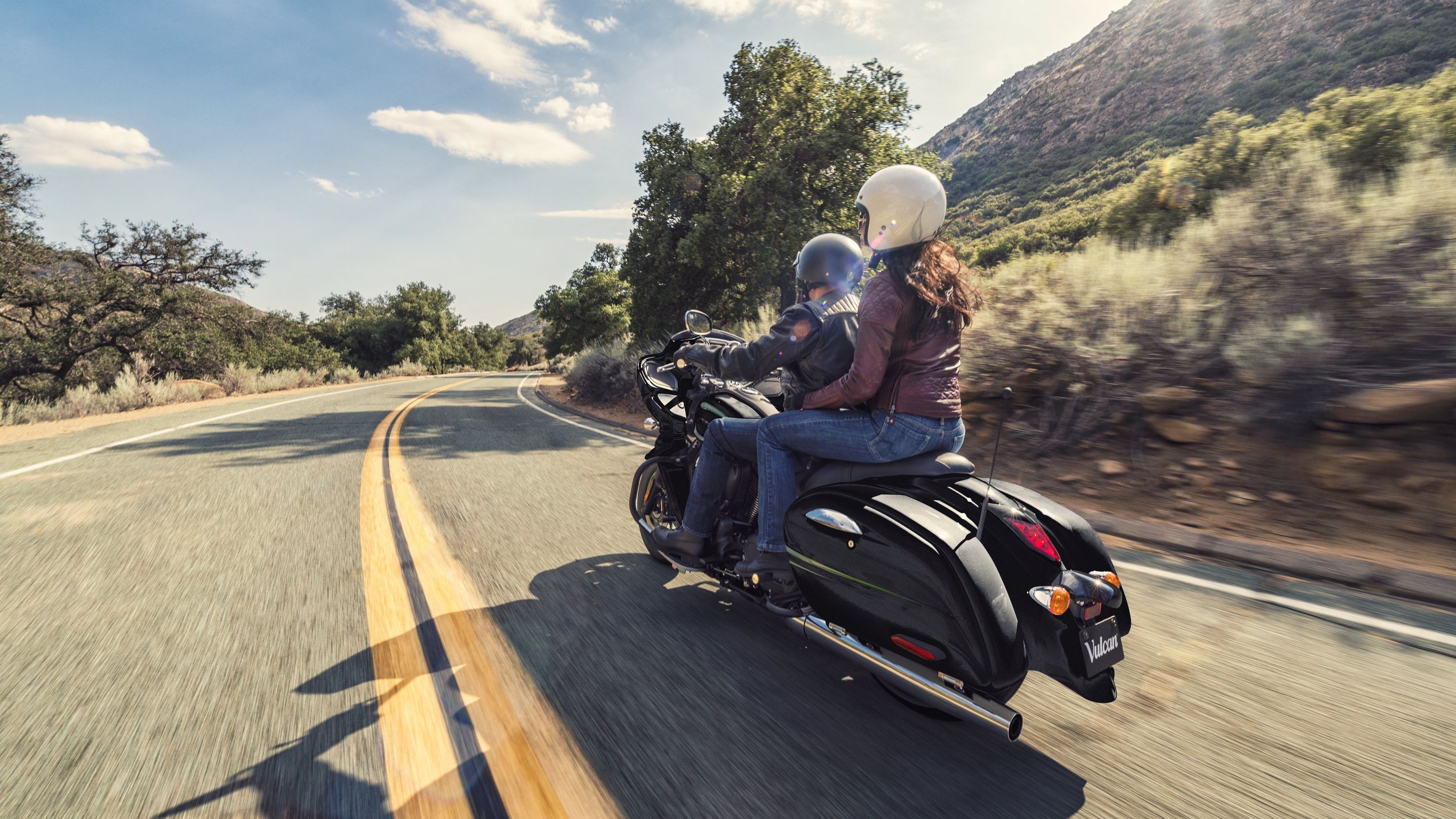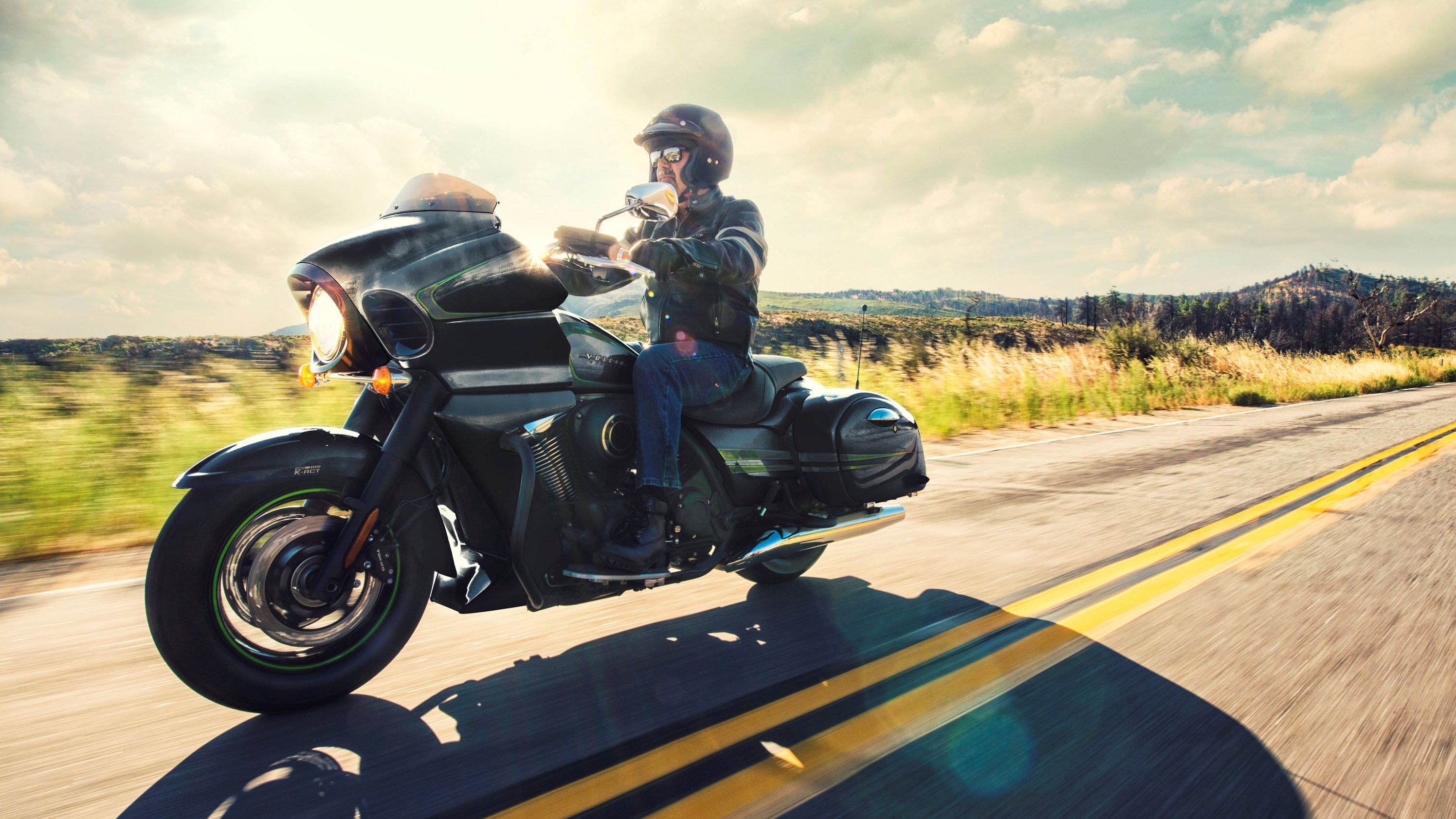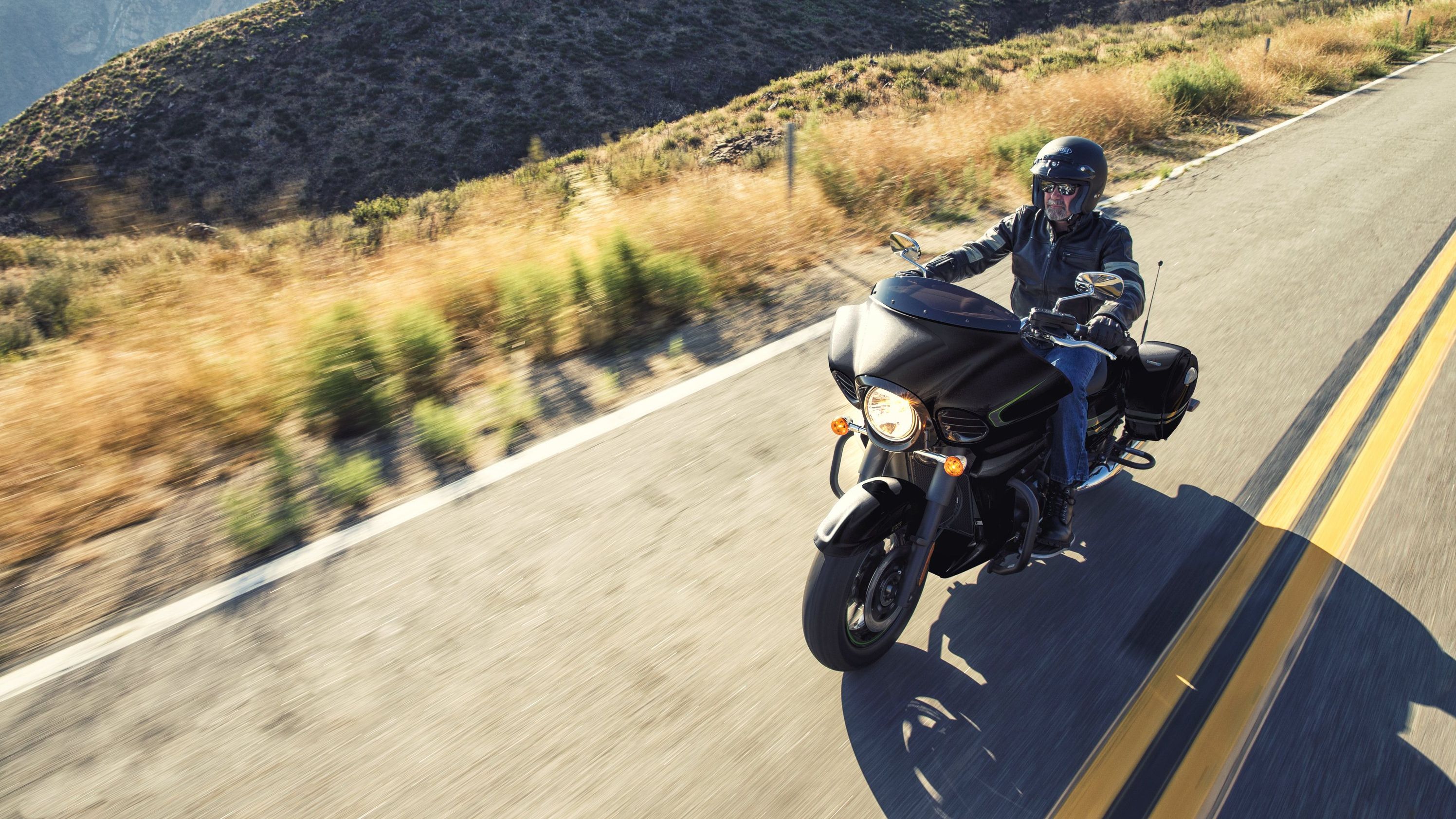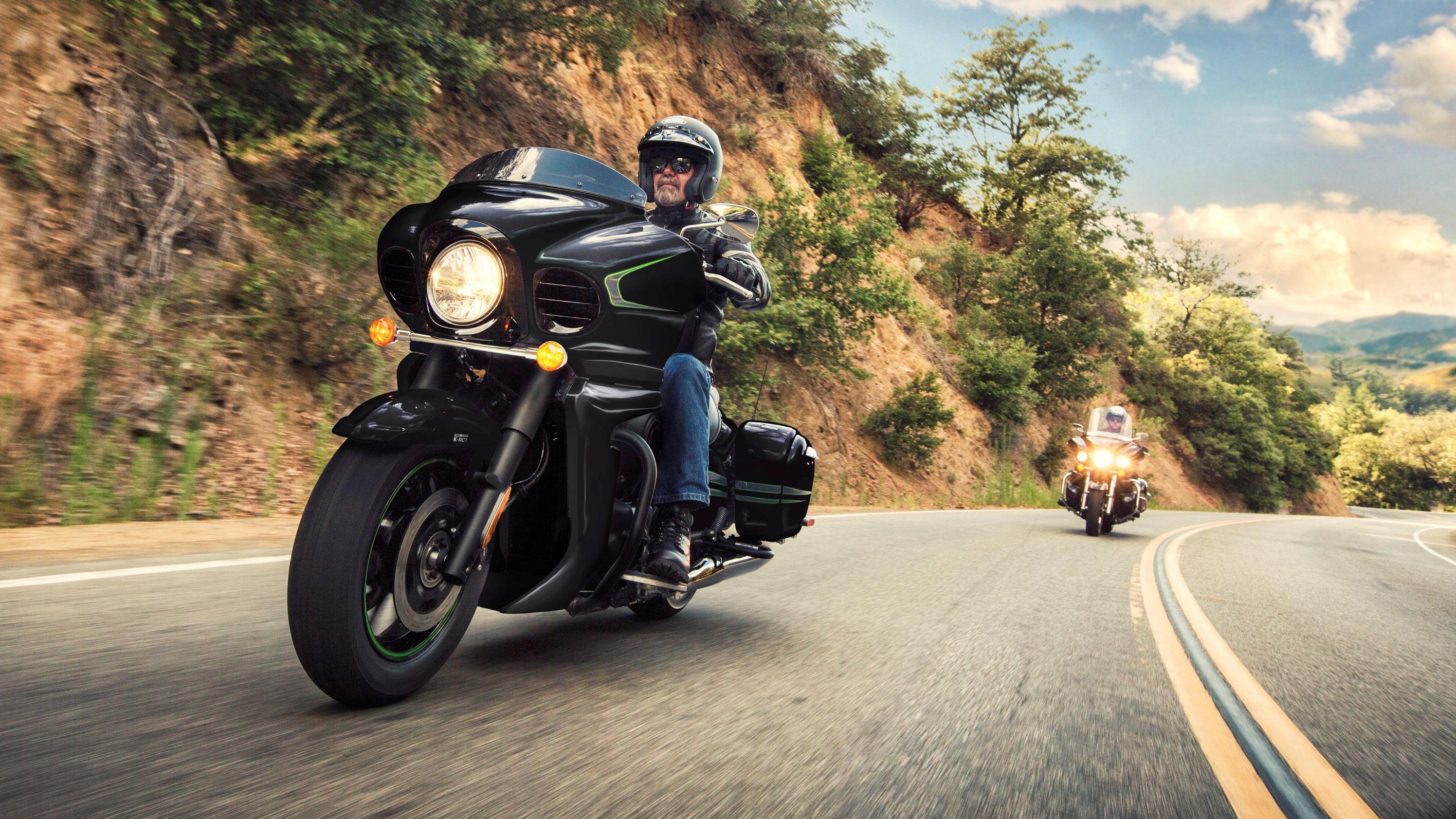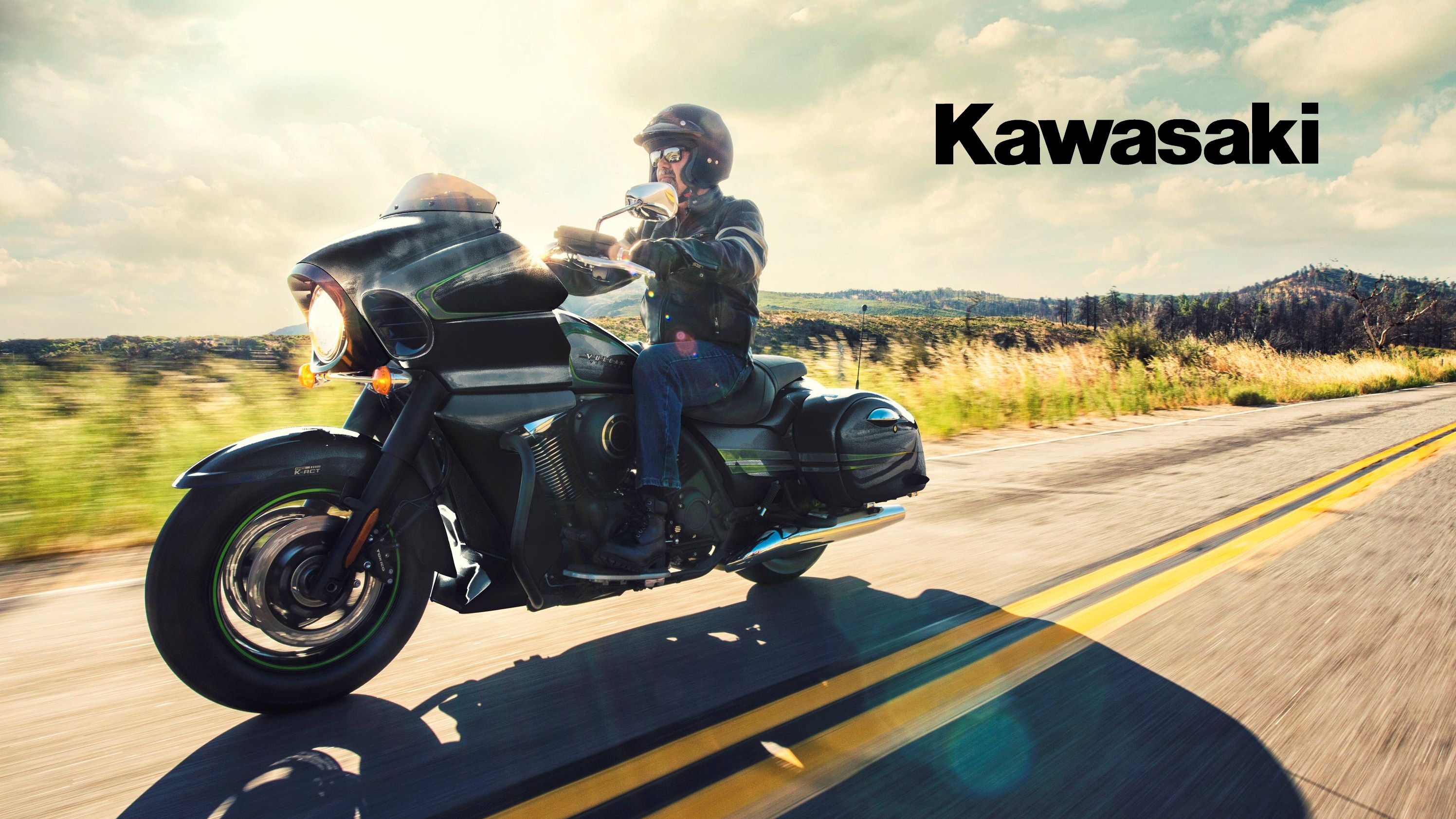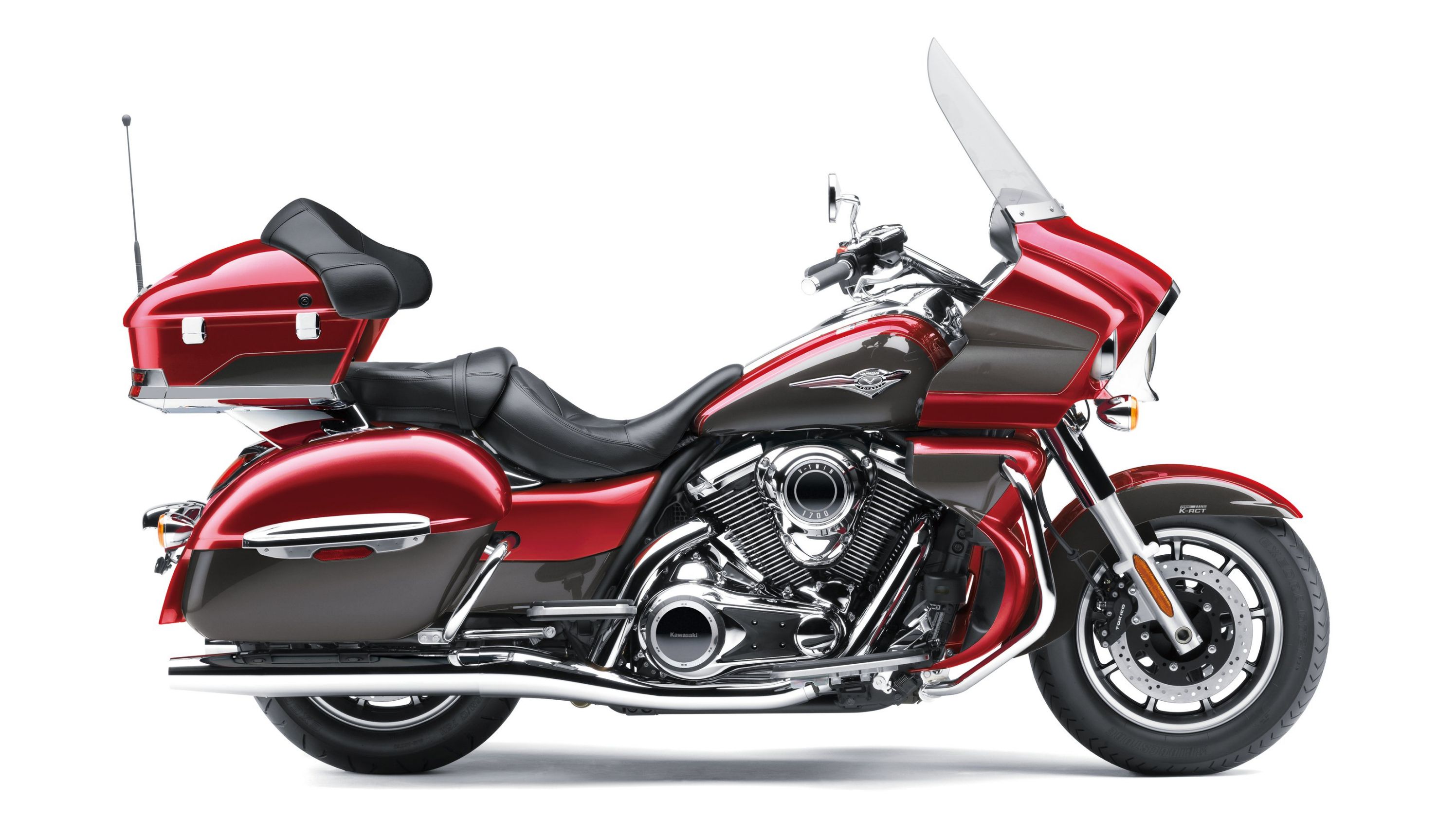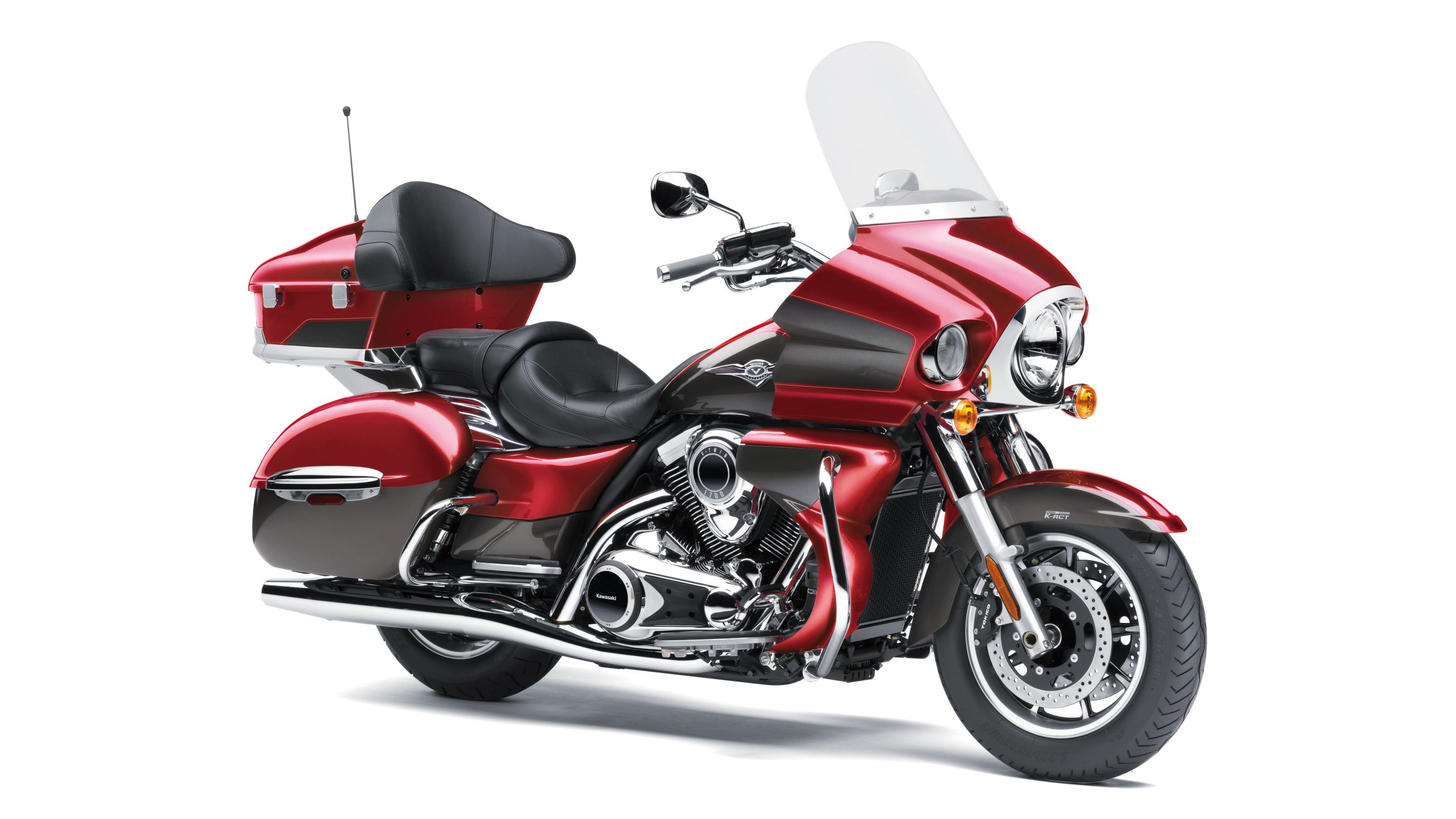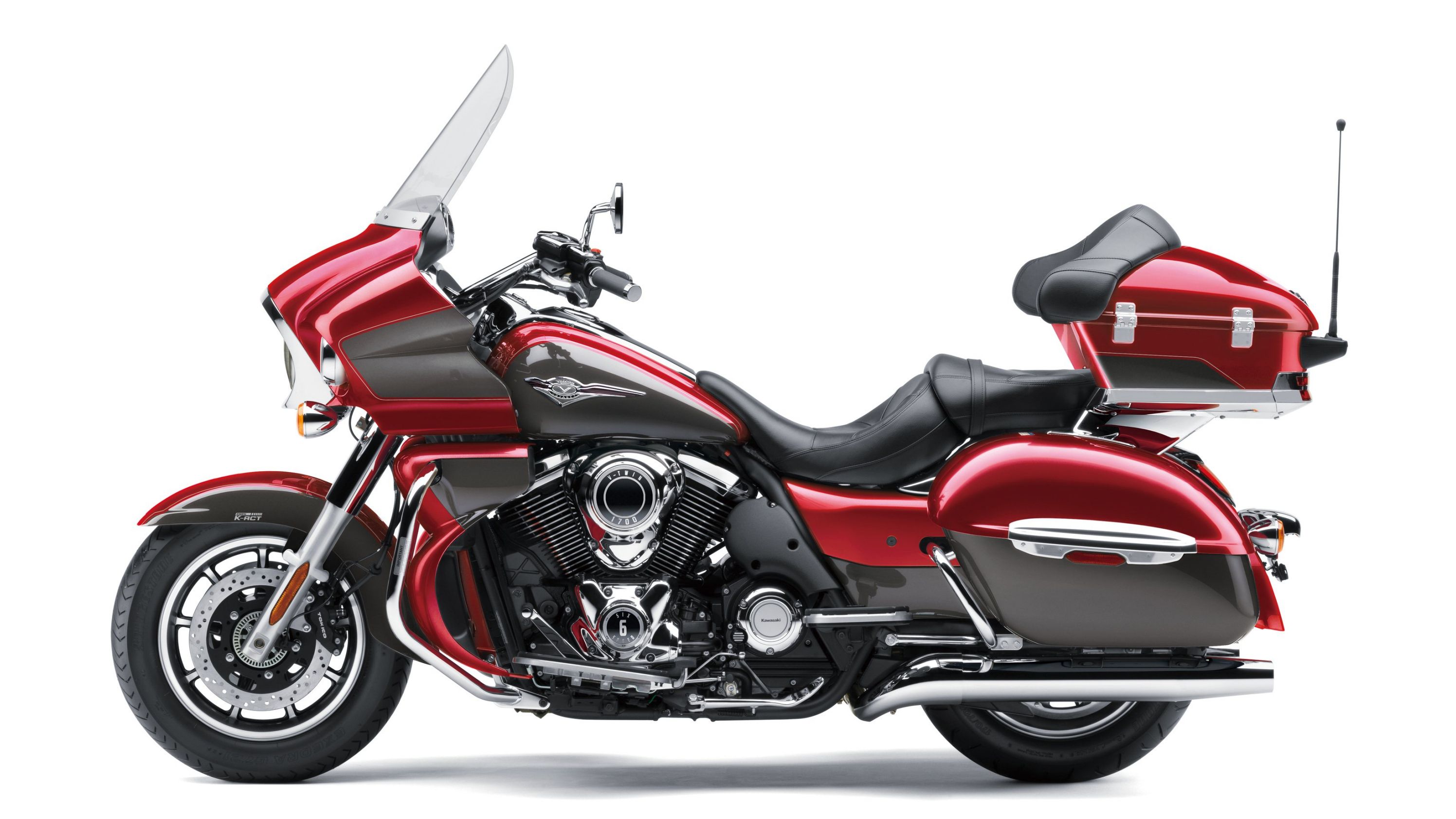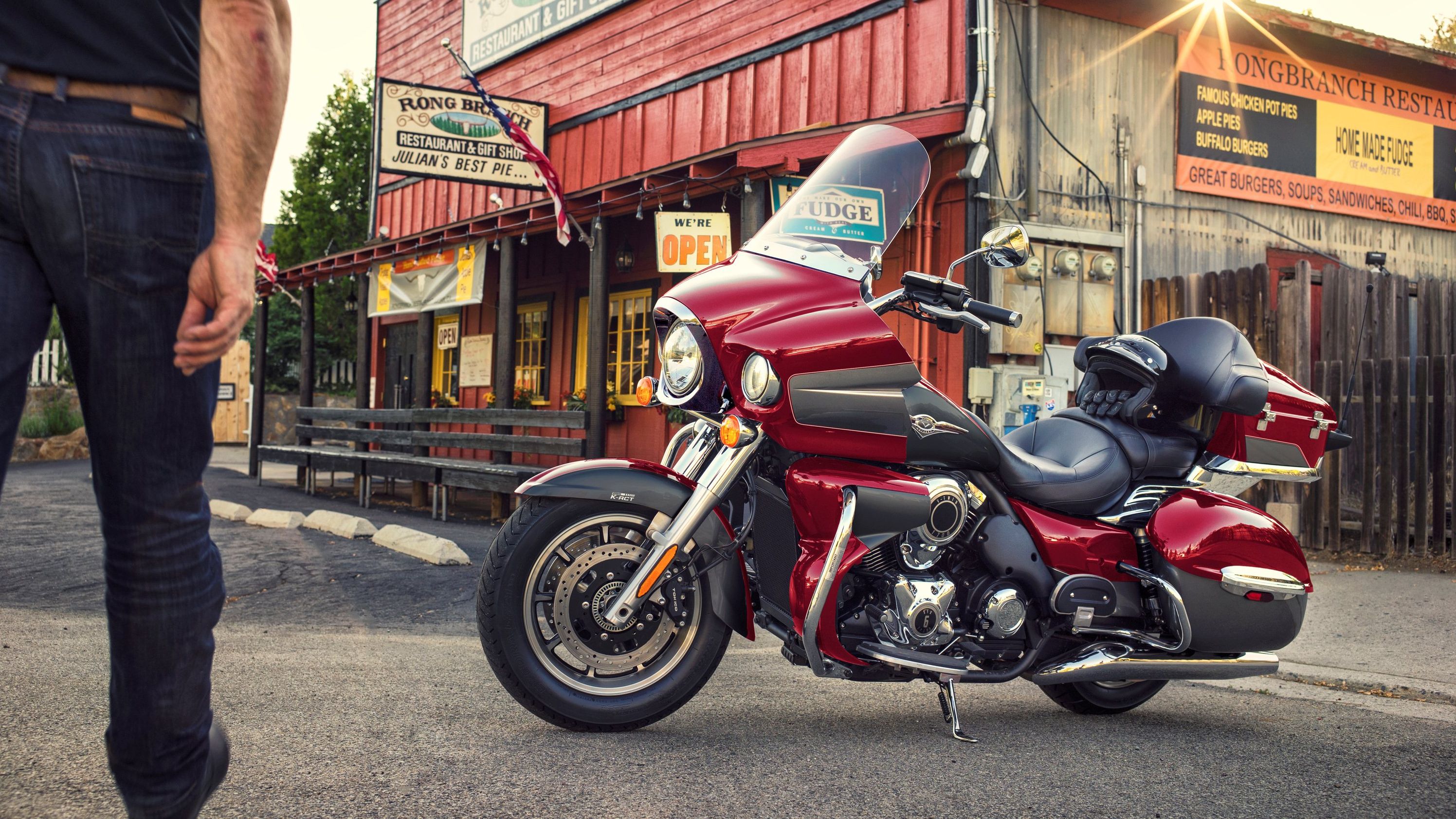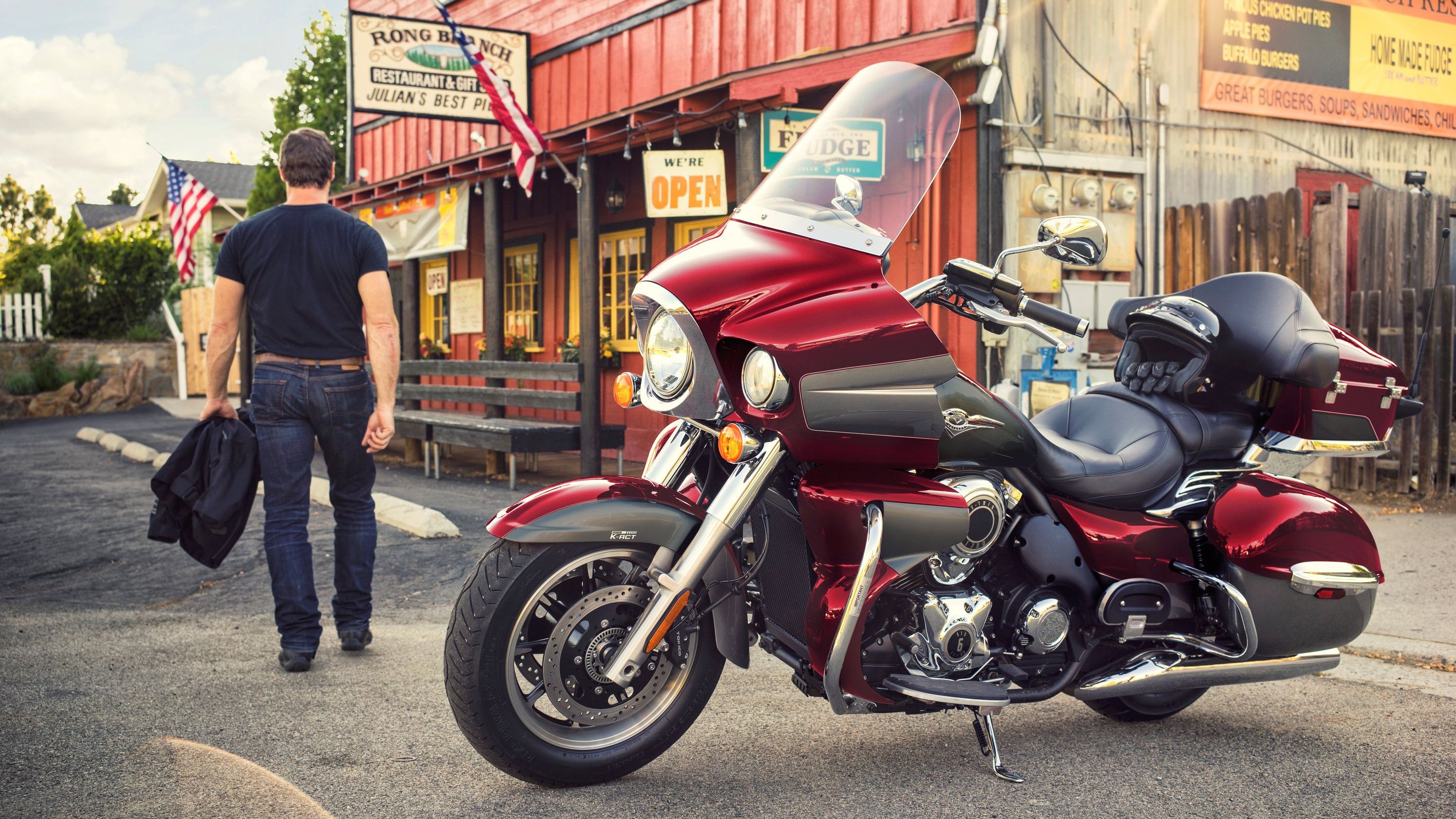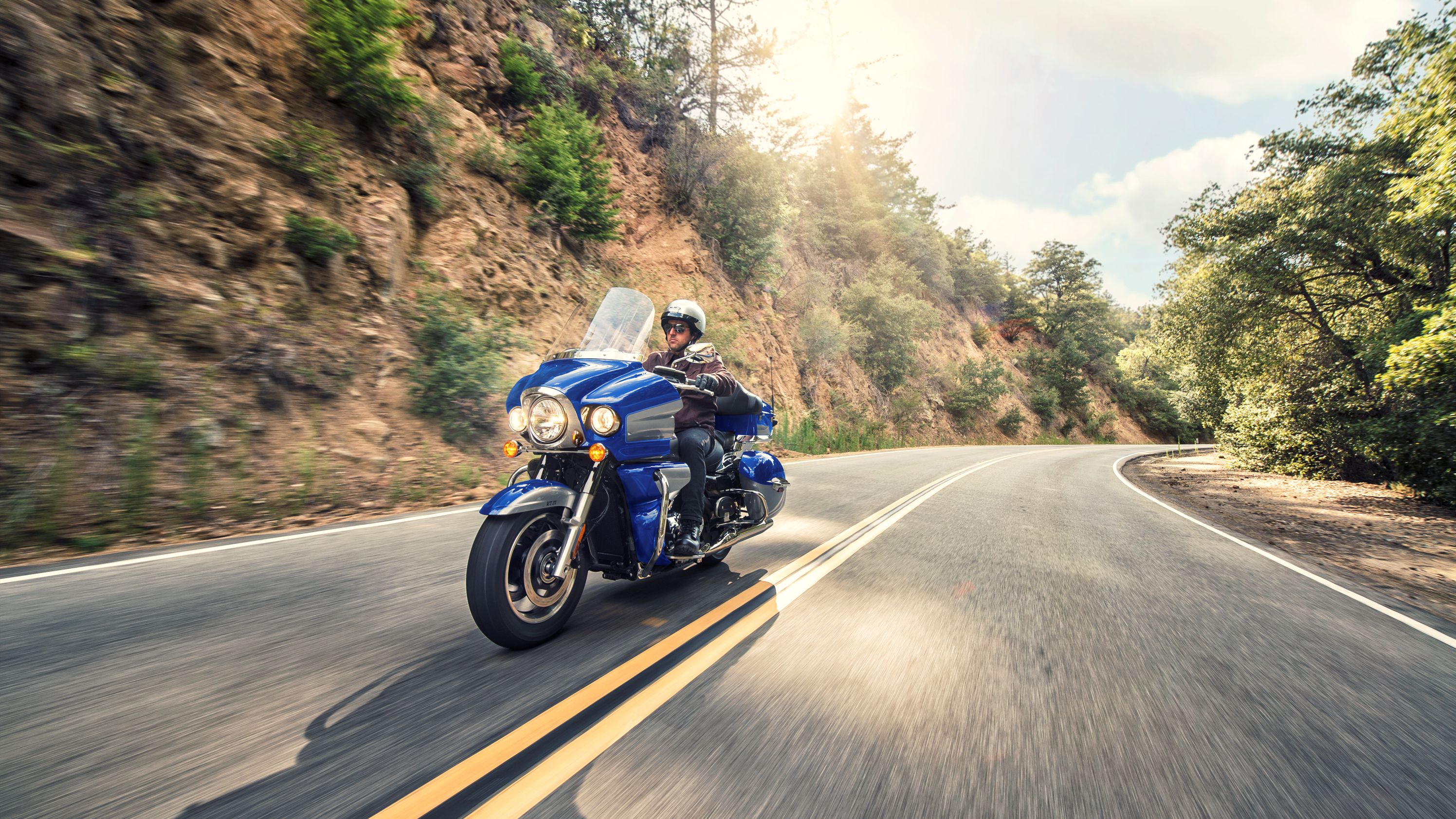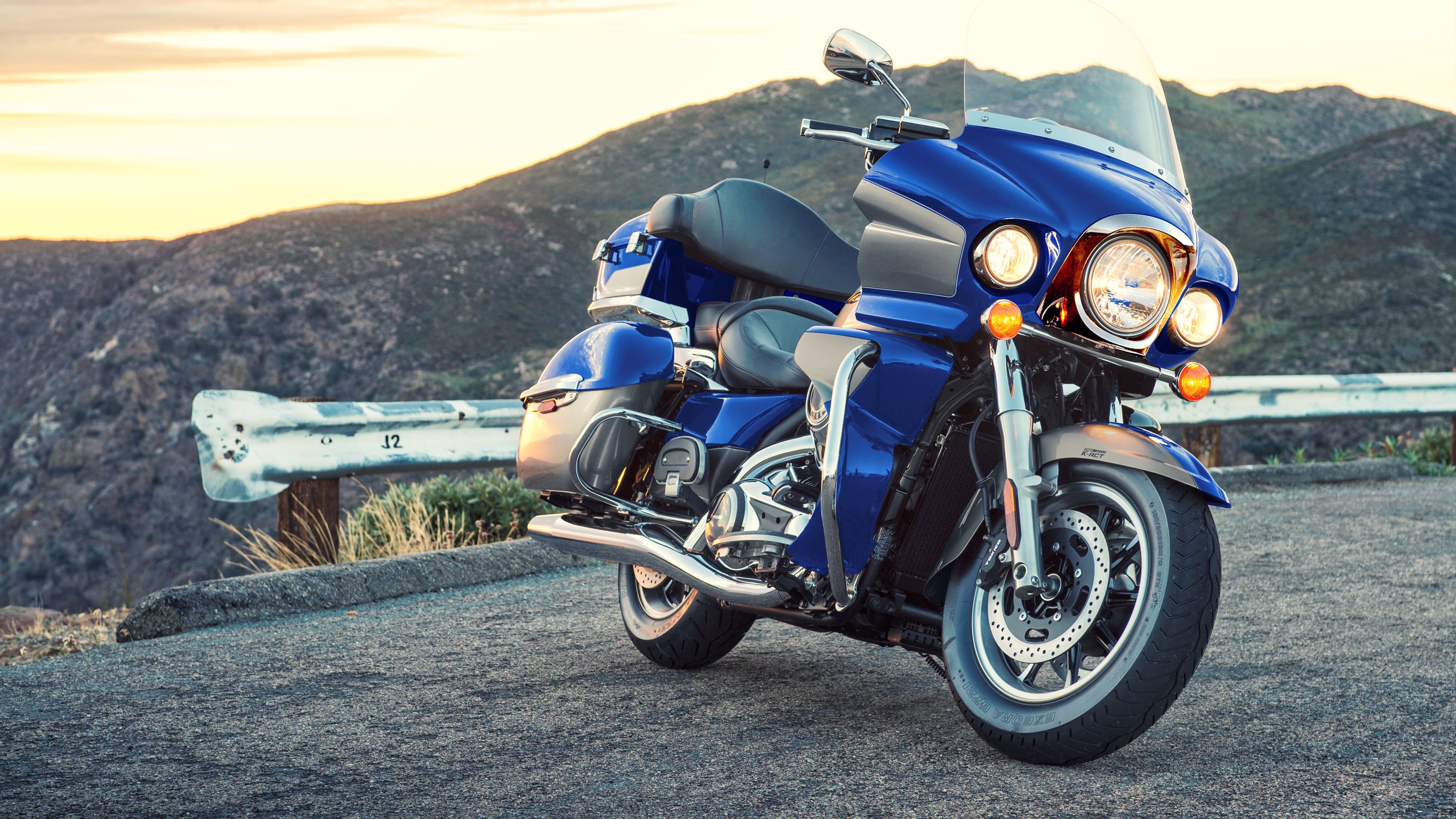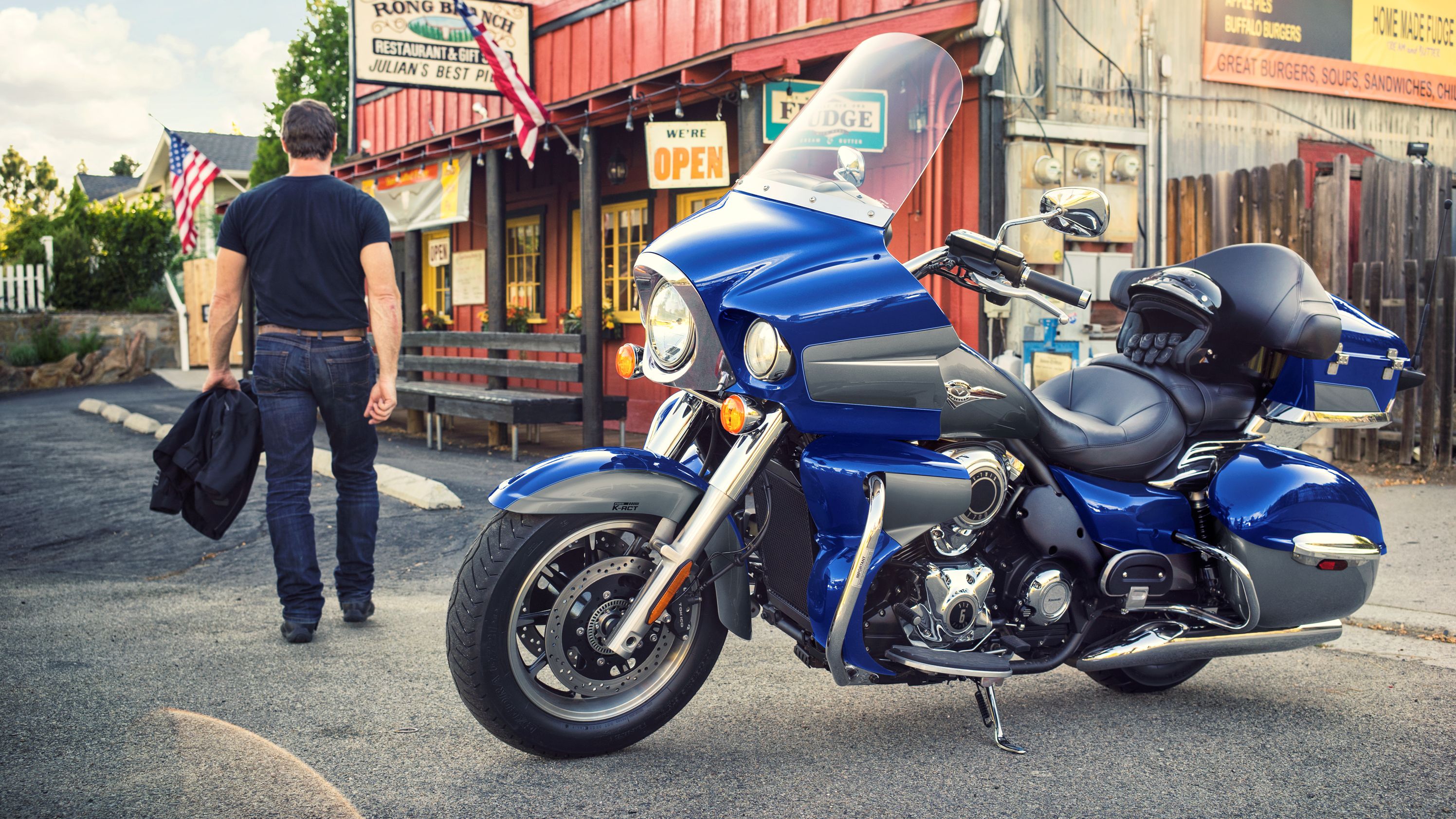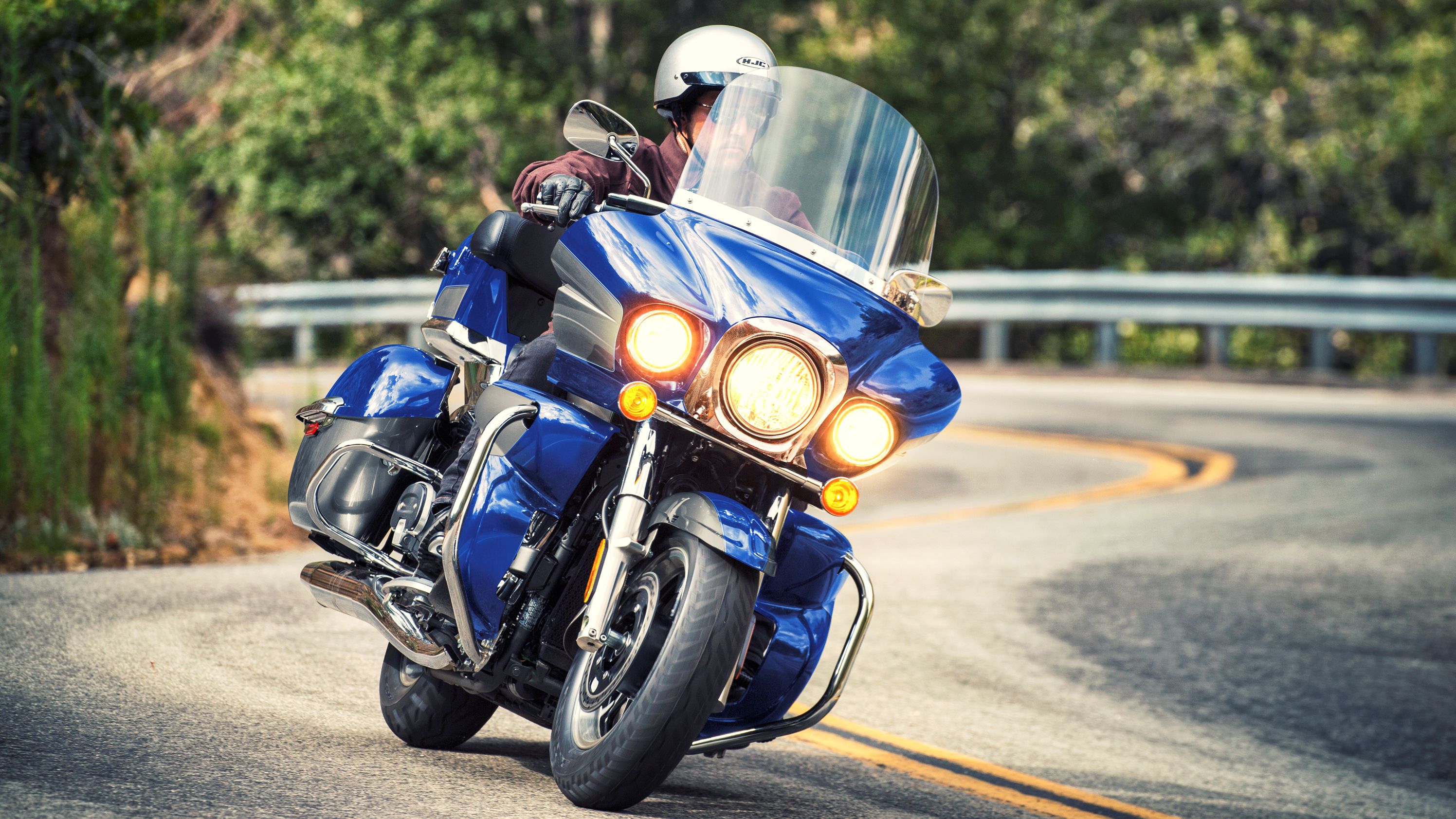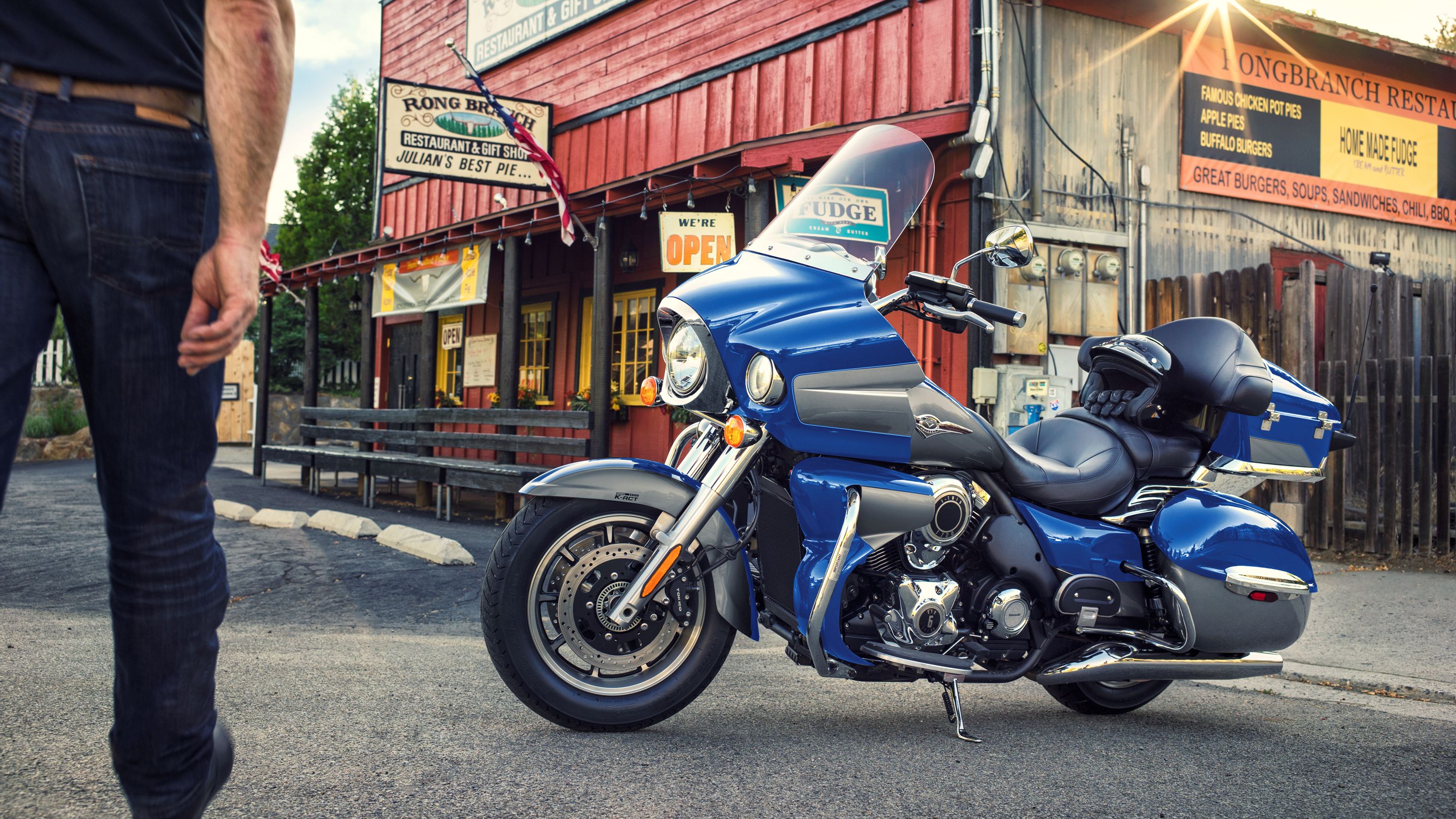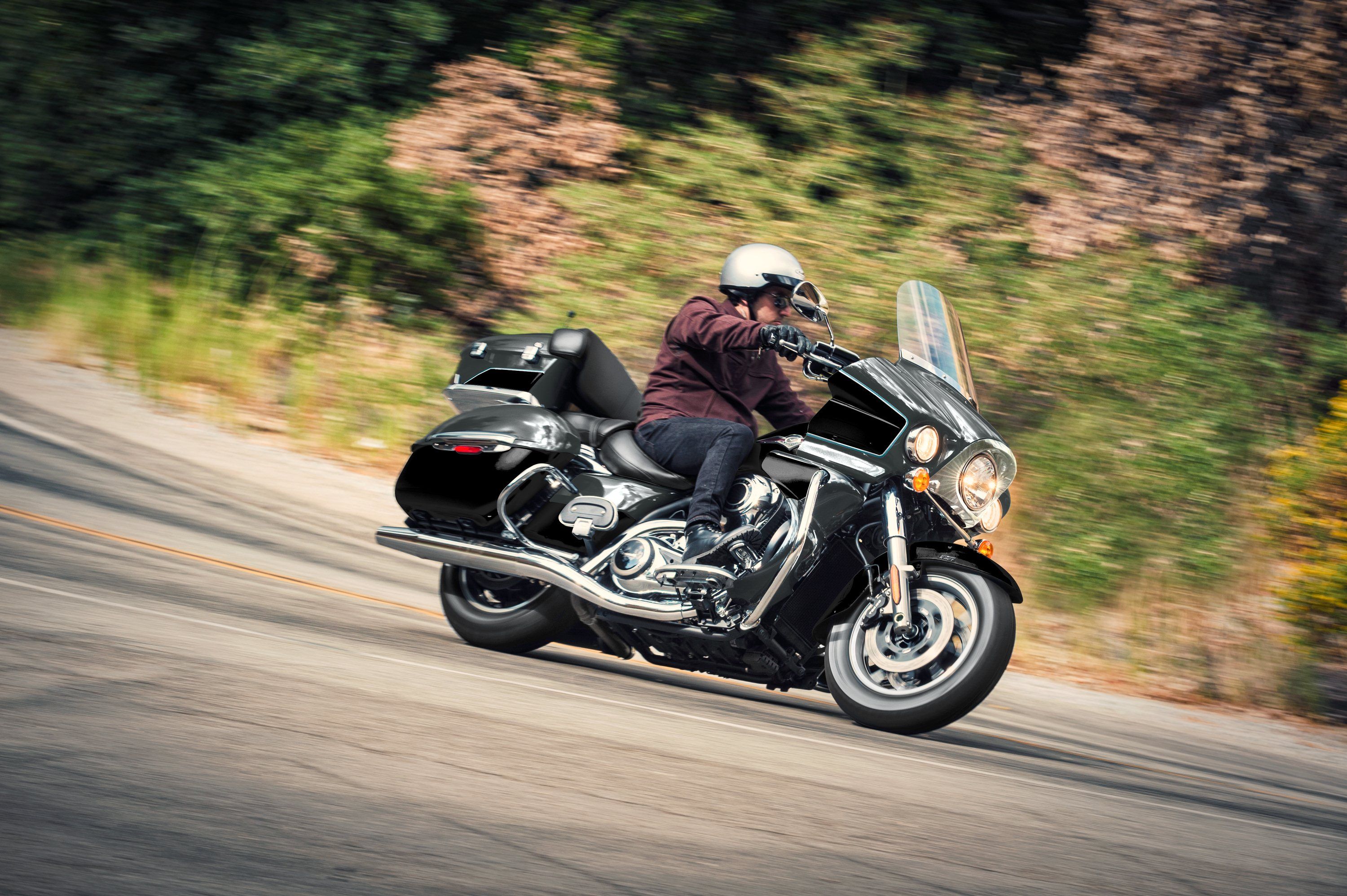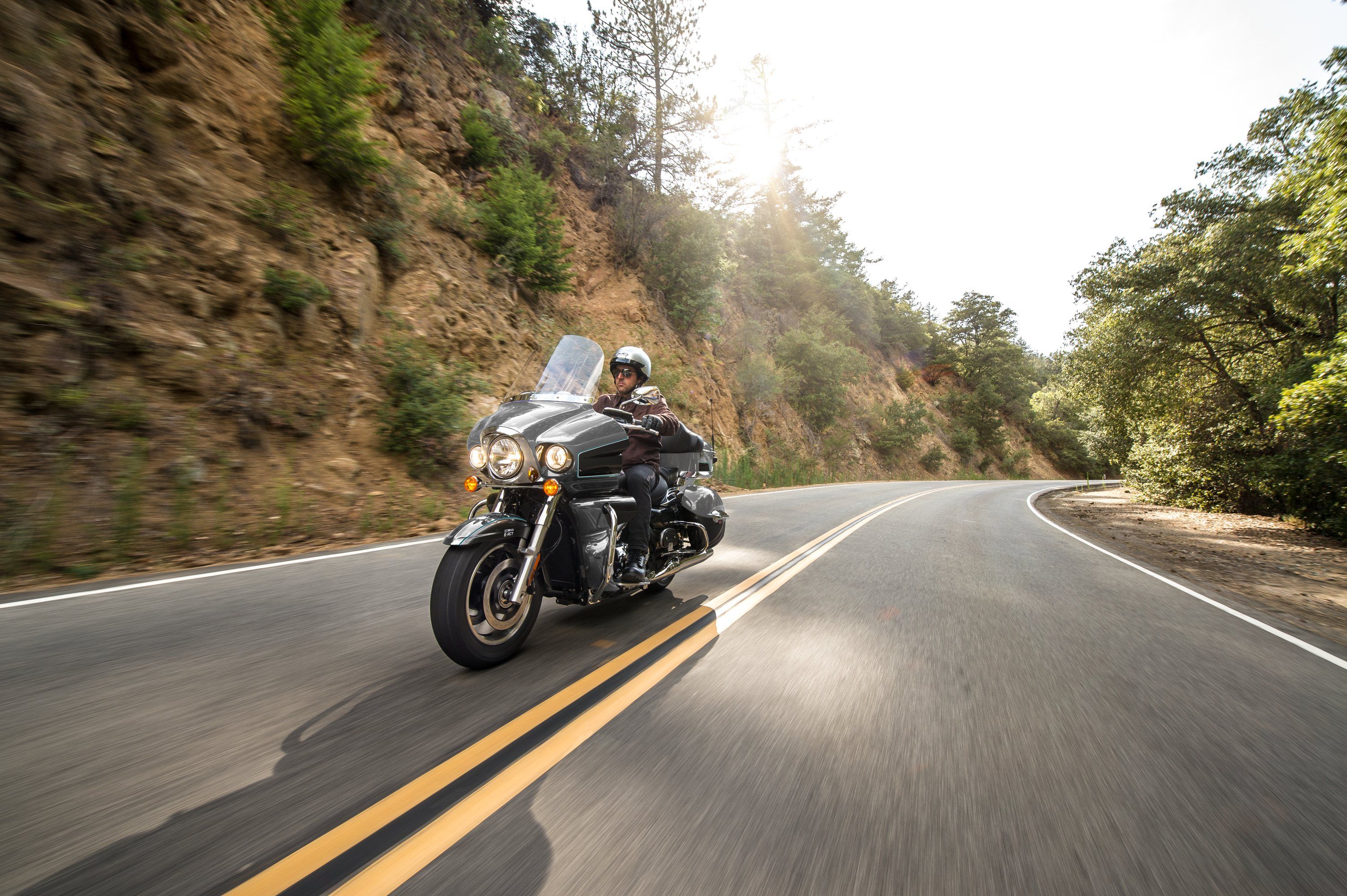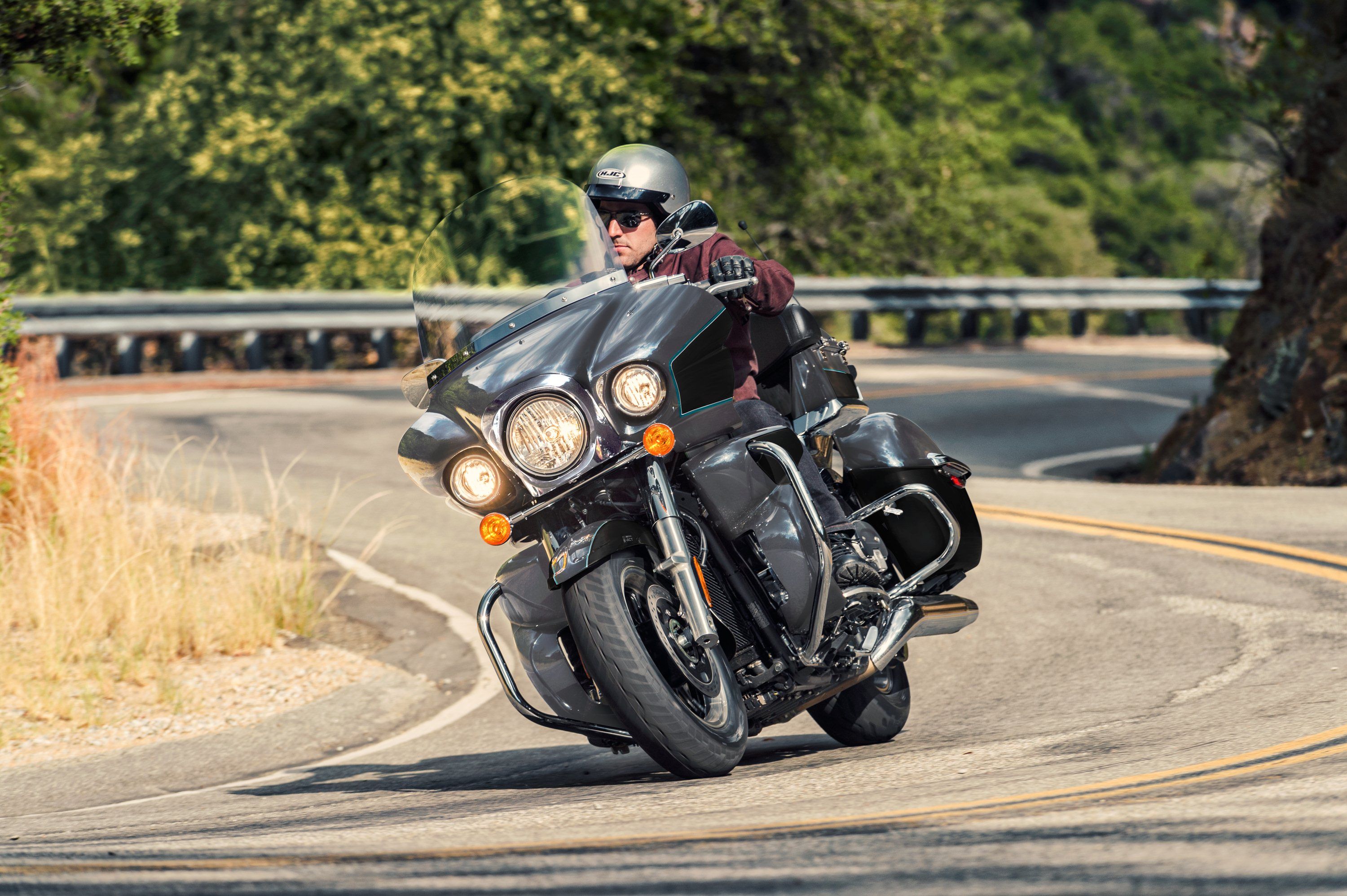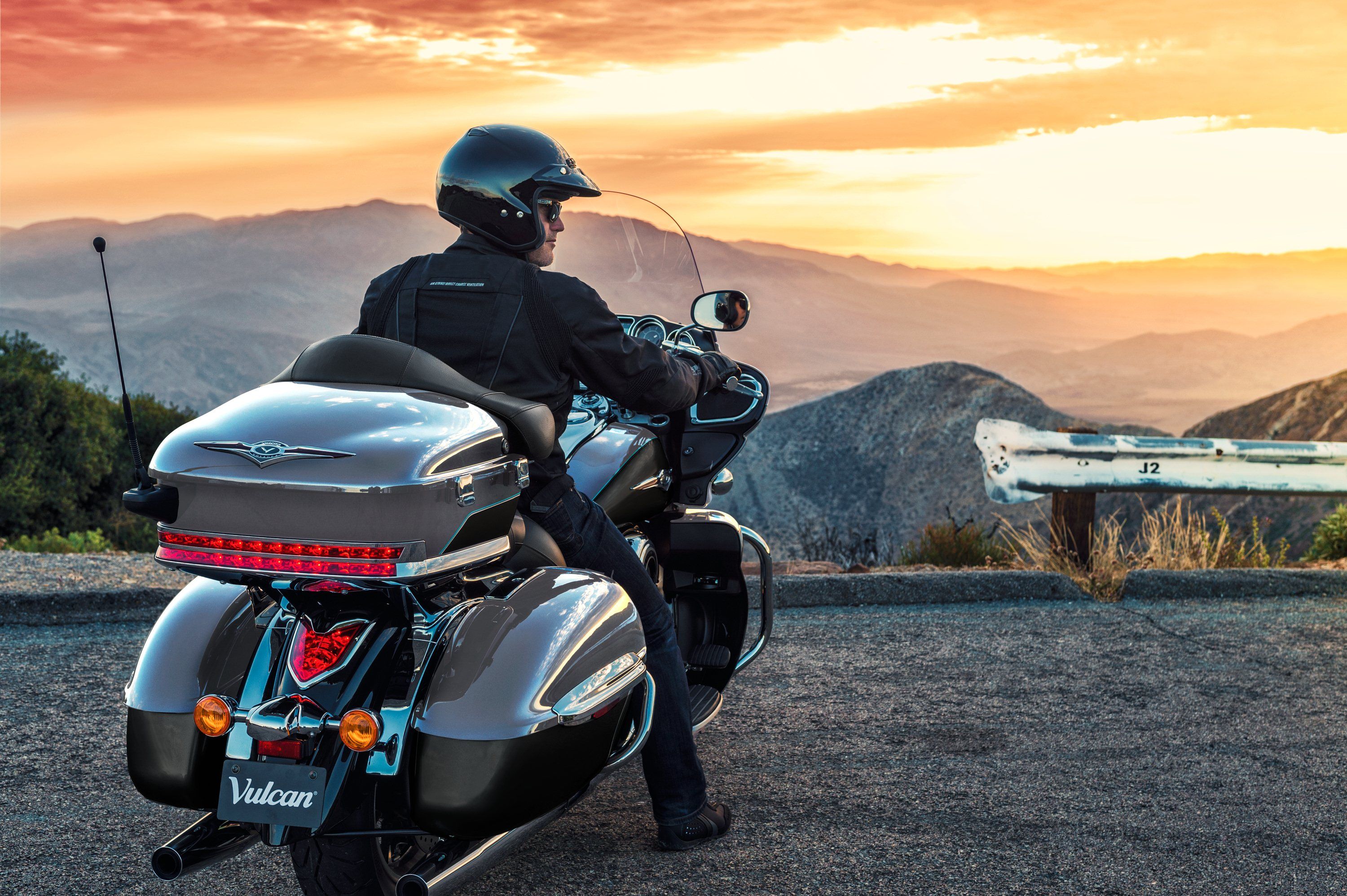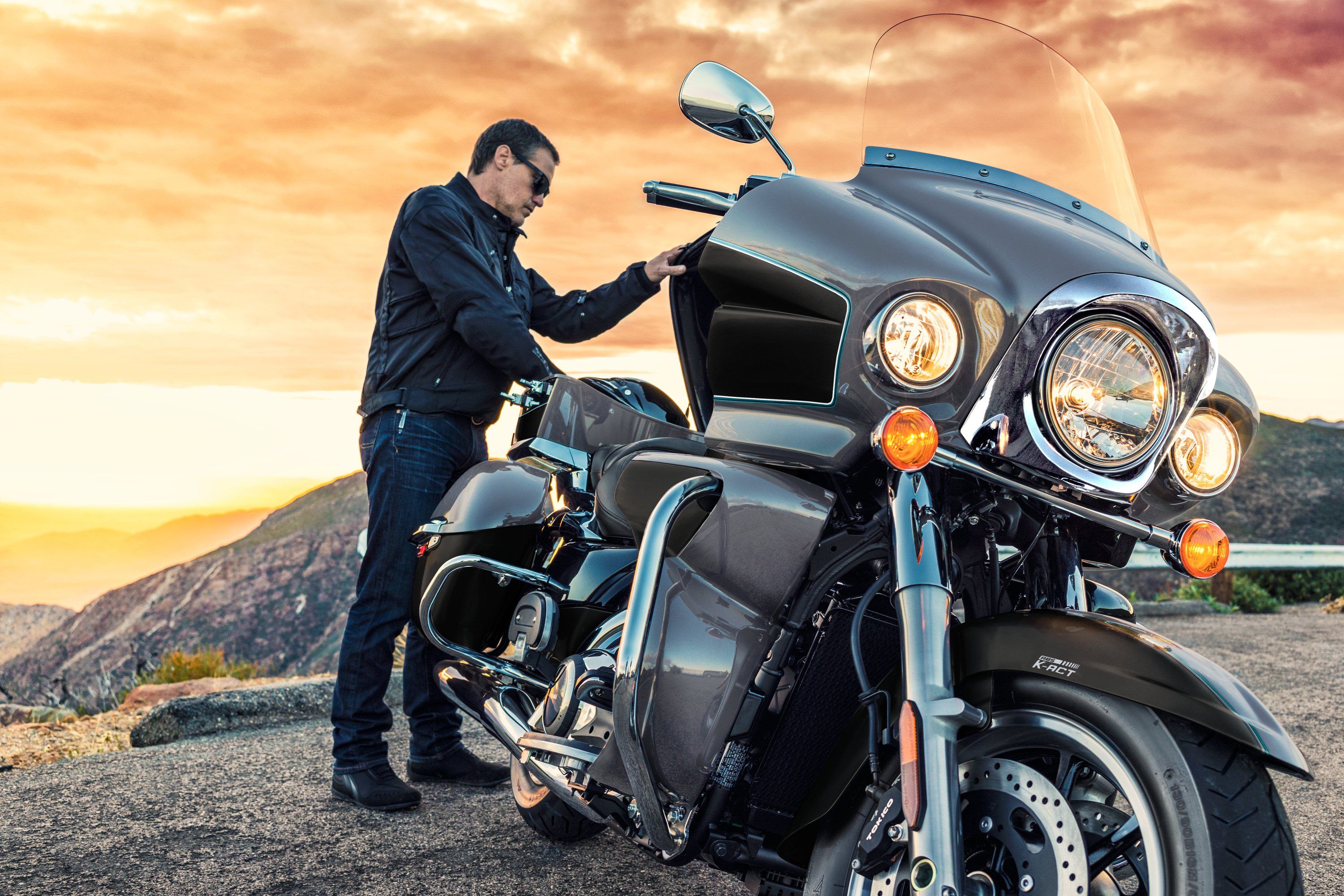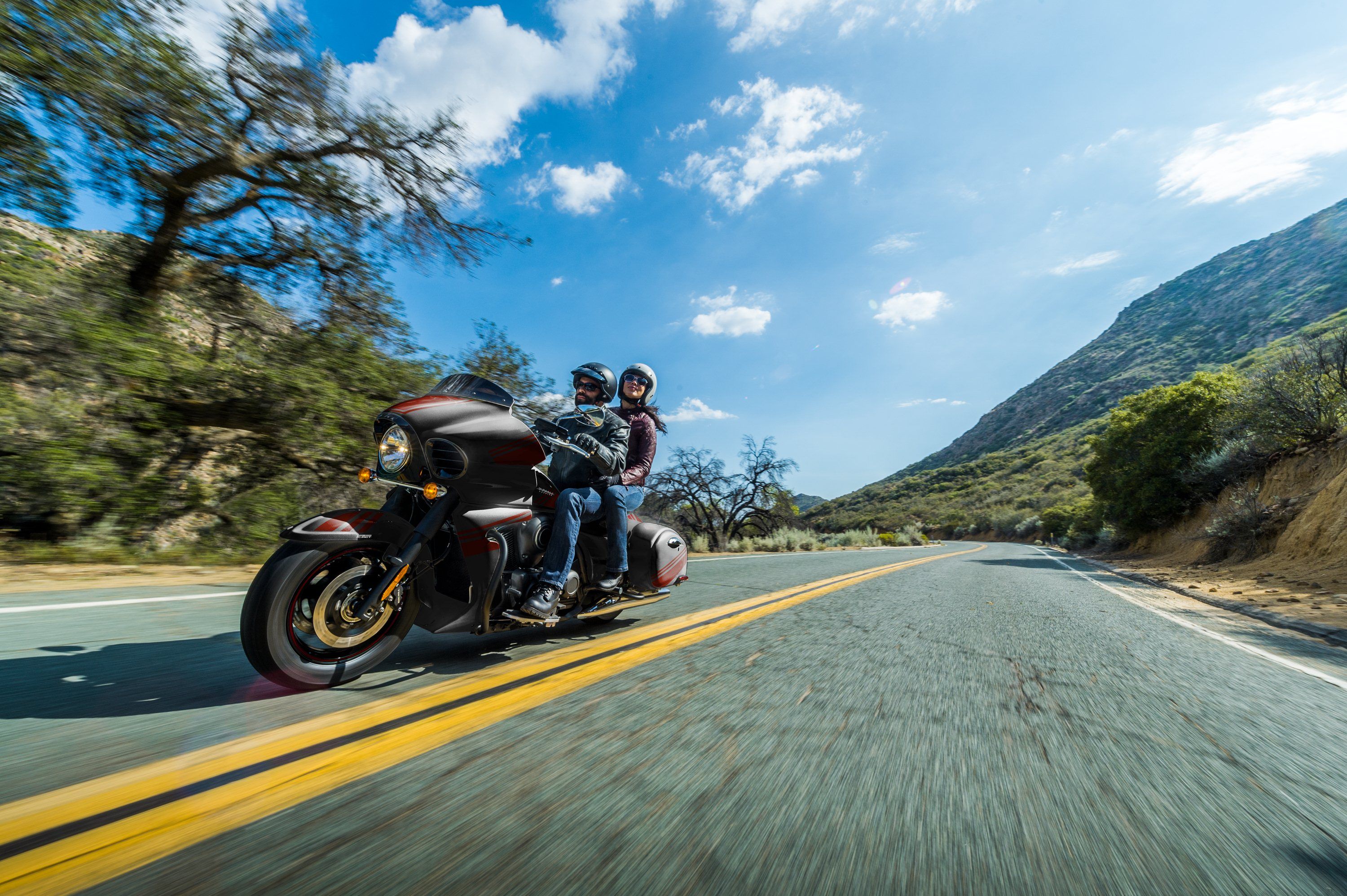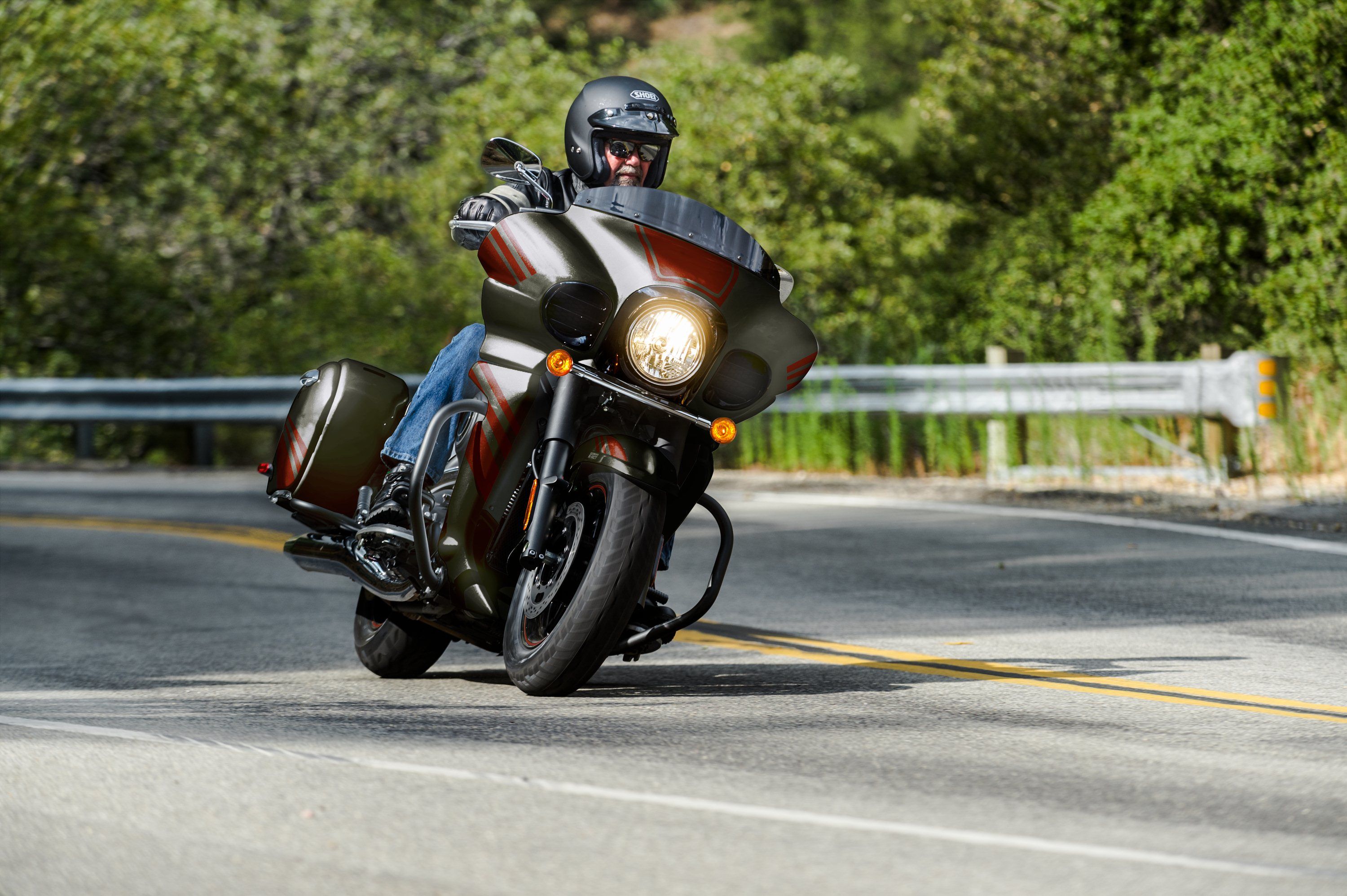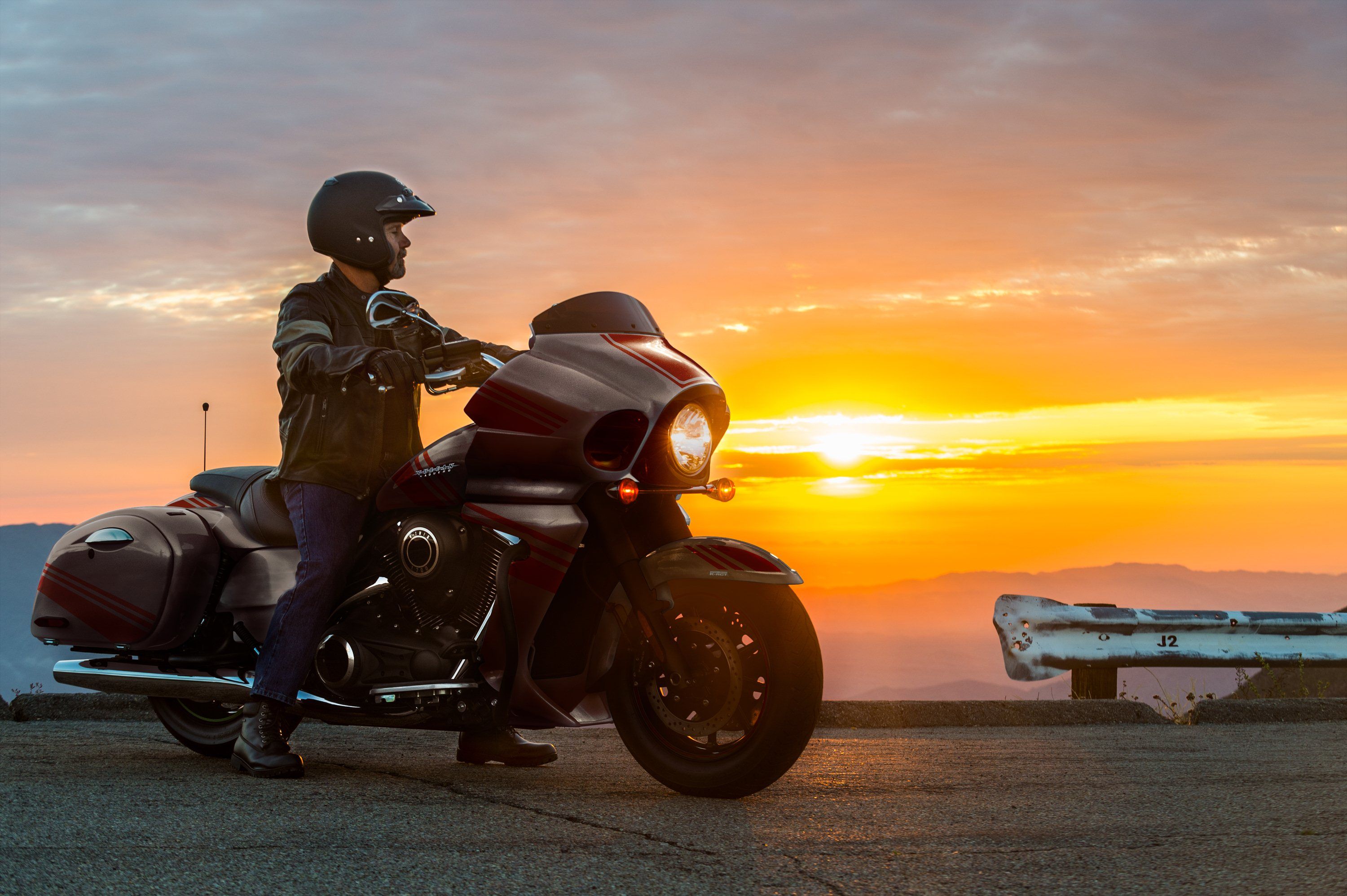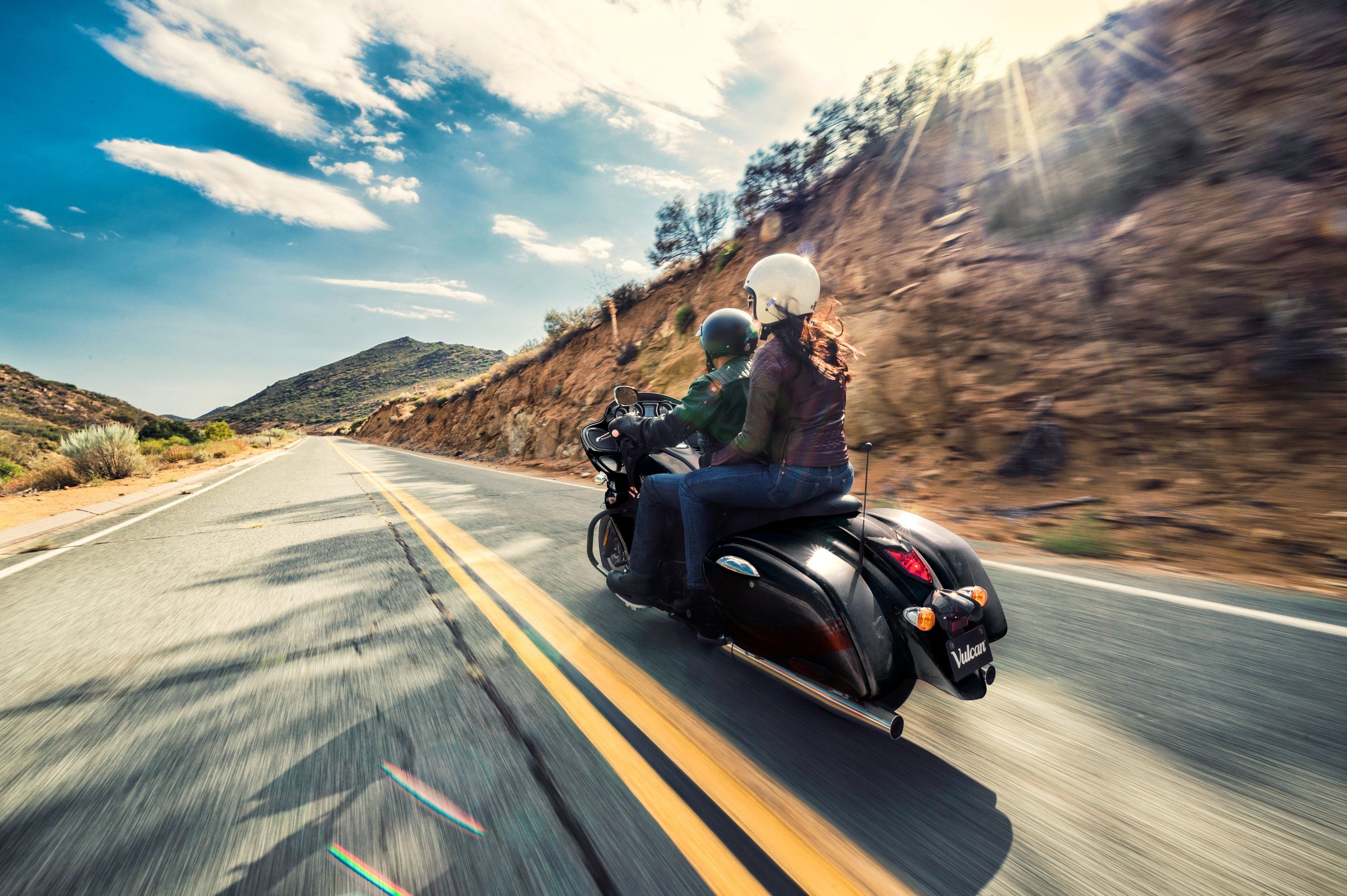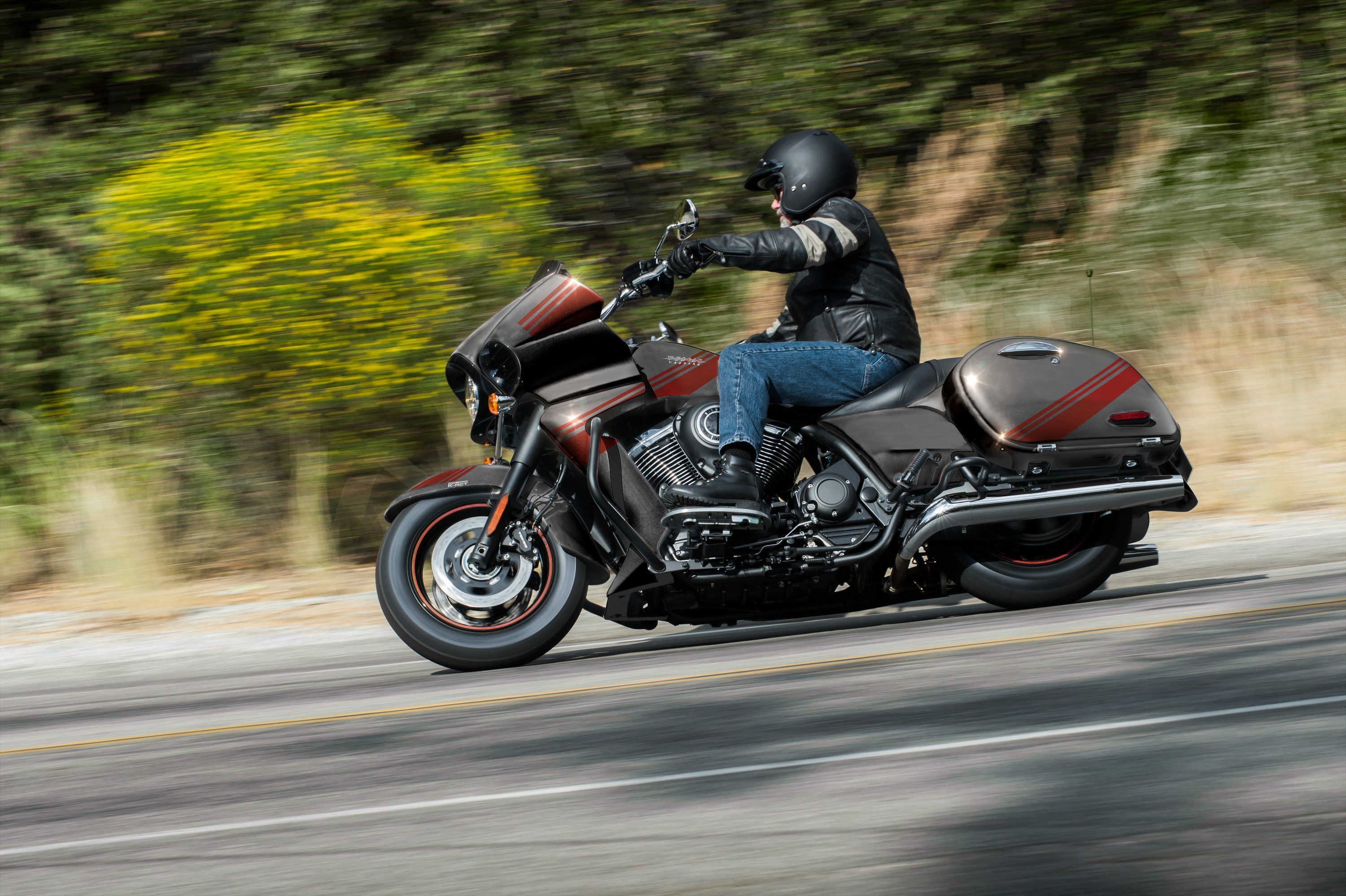Kawasaki's Vulcan 1700 line is well established with the Vaquero and the Voyager -- a bagger and full dresser, respectively -- both come with ABS and, as the name suggests, the 1700 cc engine in the V-twin configuration with liquid cooling and a six-speed transmission. Ready for a cruise around town or hitting the open road, the Vulcan 1700s are well fitted and all-around solid.
2015 - 2022 Kawasaki Vulcan 1700 Vaquero / Vulcan 1700 Voyager
- Make: Array
- Model: 2015 - 2022 Kawasaki Vulcan 1700 Vaquero / Vulcan 1700 Voyager
- Engine/Motor: V-twin
- [do not use] Vehicle Model: Array
Kawasaki Vulcan 1700 Design
The Vulcan 1700 series from Kawasaki launched in 2009 replacing the existing 1600 series and carried forward the Vulcan family that started in 1984. Kawasaki calls it “hotrod-style” elements on the dash and I wanted to see if I agreed with their claim. I do. The color-matched dash holds analog gauges, at least the main gauges: fuel, speedometer, tach and temperature (it is liquid-cooled, yes?) that I find easier to read at a glance with my ol' lady eyesight than digital readouts that are hard to see anyway in bright light, at least until TFT finds its way into the established lineups.
Tech still finds a place in the classic styling with an LCD display panel and on-board amenities such as the AM/FM/WB audio system with iPod® and SiriusXM® compatibility and speed-sensitive volume control. I expect a touring bike to have at minimum a decent sound system, so no whining here.
Do I consider dual locking side cases and, for the Voyager, a top case big enough to hold two full-face helmets noteworthy? Not really; not anymore. I expect it from a touring bike so no disappointment in the Vulcan 1700s. Small, lockable glove boxes below the speakers give you places to store your bits and bobs. The Vaquero with its blacked-out bruiser-cruise appeal has black trim on the turn signals, tail light and instrument panel in 2016 to continue that dark look. The full-dresser sibling, the Voyager features a tall, touring windscreen and a top case.
Cruise control is a bit easier to get to and can be set and adjusted from the right side of the handlebar. It's a proper cruise control, not just a throttle lock. Push-button action sets the cruise control to as low as 30 mph up to 85 mph using a toggling switch to adjust your speed without leaving cruise-control mode. It does a good job of maintaining your speed even on hills.
Kawasaki Vulcan 1700 Chassis
The half-ton-plus (bike, rider, and gear) operating weight of the Vulcan 1700 pair shows the factory dropped all pretension of keeping things light, and built for strength instead. Steel makes up the tubing for the double-downtube, double-cradle frame and squared-off backbone member, and that brings its own obvious advantages over aluminum skeletons.
The steering head angle, forks, and 16-inch wheels leaves us with a 30-degree rake and 7-inch trail on 65.6-inch wheelbase, right near the upper end of the spectrum, so you should be able to expect a reasonably stable ride at speed and good tracking in a crosswind. You can also expect it to be a little reluctant in the corners, but most of you already know you don't get to have it both ways. All this adds up to over 100 inches of bike, and one fairly large footprint. Long doesn't necessarily equate to tall in this case. The 28.7-inch seat height is reasonably low and should be okay for all but the shortest inseams.
Air shocks and 45 mm forks tend to the suspension duties with 5.5 inches of travel up front and 3.1 in the back. While that isn't what you would call a lot of rear-wheel travel, I will offer that air-adjustable shocks are generally fairly plush, and these come with a four-position rebound damping adjuster so at least you can get dialed in for load and conditions.
Dual, four-pot calipers bind the 300 mm front brake discs, and a twin-piston binder grabs the 300 mm rear disc. All this falls under the management of Kawasaki's proprietary ABS, the Kawasaki Advanced Coactive-braking Technology (K-ACT II).
|
Frame Type: |
Steel, double-cradle with box-section single-tube backbone |
|
Rake/Trail: |
30 degrees / 7.0 in |
|
Front Suspension / Wheel Travel: |
45 mm hydraulic fork / 5.5 in |
|
Rear Suspension / Wheel Travel: |
Swingarm with twin air-assisted shocks, with 4-way rebound damping / 3.1 in |
|
Front Tire: |
130/90x16 |
|
Rear Tire: |
170/70x16 |
|
Front Brakes: |
Dual 300mm discs, dual four-piston calipers, K-ACT II ABS |
|
Rear Brakes: |
Single 300mm disc, twin-piston caliper, K-ACT II ABS |
Kawasaki Vulcan 1700 Drivetrain
Kawasaki gave the Vulcan 1700 family what the American buyer likes to see, lots of inches in a V-twin configuration. At 1,700 cc (103.7 cubic-inches), this is one of the larger V-twins, and even though it has a lot of mass to get moving, you can argue that it has enough ass to move it. The factory claims a healthy 107.6 pound-feet of torque out of this mill, unquestionably well within power-cruiser territory.
The 102 mm bore and 104 mm stroke leaves us just a hair undersquare, and the 9.5-to-1 compression ratio means you won't have to buy the premium champagne at the pump. A pair of 42 mm throttle bodies meter the fuel, and a six-speed, overdrive ratio transmission with a positive-neutral finder sends power down the carbon-reinforced drive belt to make the final connection to the pavement.
So, the bike is a little too heavy to use as a dragster, but for cruising and touring, especially at interstate speeds, this is plenty of engine for decisive roll-ons, and the OD top gear (top two, really) makes for a reasonable cruising rpm.
|
Engine: |
Four-stroke, liquid-cooled, SOHC, four valves per cylinder, 52-degree V-twin |
|
Displacement: |
1,700 cc / 103.7 cu in |
|
Bore x Stroke: |
102 mm x 104 mm |
|
Compression ratio: |
9.5:1 |
|
Maximum Torque: |
108 lb-ft @ 2,750 rpm |
|
Fuel System: |
DFI® with dual 42 mm throttle bodies |
|
Ignition: |
TCBI with digital advance |
|
Transmission: |
Six-speed with overdrive and positive neutral finder |
Kawasaki Vulcan 1700 Pricing
MSRP on the 2022 Vaquero is $17,399 and the Voyager is $18,099. Kawasaki covers your Vulcan 1700 with a 36-month limited warranty with the option to go for 12, 24, or 36 months with Kawasaki Protection Plus.
|
Model: |
Vaquero |
Voyager |
|
Warranty: |
36 Month Limited Warranty (optional Kawasaki Protection Plus™ 12, 24, or 36 months) |
36 Month Limited Warranty (optional Kawasaki Protection Plus™ 12, 24, or 36 months) |
|
Colors: |
||
|
└ 2015: |
Candy Lime Green, Metallic Carbon Gray |
Metallic Carbon Gray/Metallic Spark Black |
|
└ 2016: |
Pearl Crystal White |
Metallic Phantom Silver/Metallic Spark Black |
|
└ 2017: |
Candy Cardinal Red |
Pearl Meteor Gray/Metallic Spark Black |
|
└ 2018: |
Metallic Spark Black |
Candy Cardinal Red/Metallic Graystone |
|
└ 2019: |
Metallic Spark Black |
Candy Imperial Blue/Metallic Graphite Gray |
|
└ 2020: |
Candy Imperial Blue |
Metallic Carbon Gray/Metallic Spark Black |
|
└ 2021: |
Metallic Carbon Gray/Metallic Spark Black |
Pearl Meteor Gray/Metallic Spark Black |
|
└ 2022: |
Metallic Matte Graphenesteel Gray |
Pearl Robotic White/Pearl Nightshade Teal |
|
Price: |
||
|
└ 2016: |
$16,699 |
$17,399 |
|
└ 2017-2020: |
$16,799 |
$17,499 |
|
└ 2021: |
$16,999 |
$17,699 |
|
└ 2022: |
$17,399 |
$18,099 |
Kawasaki Vulcan 1700 Competitor
There are no shortage of power-cruiser/tourers to pick from, but I find the Road Glide from Harley-Davidson to be the most natural, and probably predictable, pairing.
Harley-Davidson Road Glide
Similar enough to really get an apples-to-apples comparison, I feel like I can focus on some of the details since the broad strokes are so closely aligned. Since the Road Glide comes with the low-profile windshield and clean rear end, I'm going to go with the Vaquero here, but it is worth noting the Road Glide Ultra makes for a good competitor for the Vulcan 1700 Voyager.
Low, wide and a little mean, both contenders show that boulevard-bruiser attitude. Between the fixed fairing, fat front end, and saddle that tapers down to something just a little better than a vestigial pillion pad. I prefer the H-D style a little because of the dual headlights mainly -- definitely not feeling the cyclops headlight on the Vaquero or the fairing lowers that seem to make the fairing cover the entire front of the bike. To be fair, the lowers do good things for the radiator in terms of airflow and minimizing the visual impact of the core itself.
As far as gadgetry goes, both carry a bit, if not as much as one would like. ABS and adjustable rear shocks are present across the board, but neither offers any sort of dynamic/adjustable front suspension or any sort of traction control system, nuggets that are starting to fall onto the list of expected features. While both rides carry entertainment equipment in the form of a radio with a number of input options, H-D had to give the electronics suite a name of its own; Infotainment. Kawasaki is a little reserved on the specifics of the Vulcan family radios, so I will spare the blow-by-blow and simply state that H-D comes out on top of the stereo/electronics battle.
The Vulcan 1700 (103.7 cubic-inch) plant was just a skosh bigger than the old High Output Twin Cam 103 (103.1 cubic-inch), and a bit more powerful with 107.6 pounds of grunt versus the 104.7 pounds from the Twin Cam. The Road Glide was equipped with the new Milwaukee-Eight engine, so Harley squeaks out on top with 1,746 cc and 111.4 pound-feet of torque. Seriously, anything over 100 pound-feet of torque is plenty, so I won't quibble over a few pounds here or there. I'll save that for the price section...
...and here we are. Kawasaki delivers a punishing blow to the Road Glide with a $17,399 MSRP on the Vaquero, a significant amount less expensive than the $21,699 Road Glide. True, H-D is still the King of Paint, and enjoys a certain name recognition, but for many without brand loyalty, something in the Vulcan 1700 lineup may be up your alley.
Read our full review of the Harley-Davidson Road Glide.
He Said
My husband and fellow writer, TJ Hinton, says, “Gotta say, the Vulcan 1700 family looks an awful lot like the Road Glide/Road Glide Ultra, or even the Magnum or 8-Ball from Victory. Like, an awful lot. At the very least, you can be sure that it falls within the bruiser look as is currently in-vogue, and does provide a less-expensive alternative for someone looking for that look and feel, but not necessarily enamored with the existing American fare.”
She Said
“It has floorboards -- not a surprise for a cruiser/touring bike -- and you'll scrape them a lot if you like to throw a big bike around, but that also shouldn't be a surprise. It has plenty of power and lots of torque that comes on early. For a big, heavy bike, it's surprisingly responsive. If you plan to spend time on the interstate, you might want to go with the touring windscreen on the Varquero to save yourself some head buffeting. Even at highway speeds, you're only cranking about 2,500 rpm so you have plenty of oomph when you need to hit the throttle. All in all, it's a nice ride and absorbs the bumps with aplomb.”
Kawasaki Vulcan 1700 Specifications
|
Engine & Drivetrain: |
|
|
Engine: |
Four-stroke, liquid-cooled, SOHC, four valves per cylinder, 52-degree V-twin |
|
Displacement: |
1,700 cc / 103.7 cu in |
|
Bore x Stroke: |
102 mm x 104 mm |
|
Compression ratio: |
9.5:1 |
|
Maximum Torque: |
108 lb-ft @ 2,750 rpm |
|
Fuel System: |
DFI® with dual 42 mm throttle bodies |
|
Ignition: |
TCBI with digital advance |
|
Cooling System: |
Liquid, plus cooling fins |
|
Transmission: |
Six-speed with overdrive and positive neutral finder |
|
Final Drive: |
Carbon fiber-reinforced belt |
|
Chassis: |
|
|
Front Suspension / Wheel Travel: |
45 mm hydraulic fork / 5.5 in |
|
Rear Suspension / Wheel Travel: |
Swingarm with twin air-assisted shocks, with 4-way rebound damping / 3.1 in |
|
Front Tire: |
130/90x16 |
|
Rear Tire: |
170/70x16 |
|
Front Brakes: |
Dual 300 mm discs, dual four-piston calipers, K-ACT II ABS |
|
Rear Brakes: |
Single 300 mm disc, twin-piston caliper, K-ACT II ABS |
|
Frame Type: |
Steel, double-cradle with box-section single-tube backbone |
|
Rake/Trail: |
30 degrees / 7.0 in |
|
Dimensions & Capacities: |
|
|
Overall Length: |
98.8 in (Voyager: 100.8 in) |
|
Overall Width: |
38.2 in (Voyager: 39.2 in) |
|
Overall Height: |
50.8 in (Voyager: 61.0 in |
|
Ground Clearance: |
5.7 in (Voyager: 5.3 in) |
|
Seat Height: |
28.7 in |
|
Fuel Capacity: |
5.3 gal |
|
Wheelbase: |
65.6 in |
|
Curb weight: |
844.5 lb (Voyager: 895.2 lb) |
|
Details: |
|
|
Special Features: |
Integrated audio system with SiriusXM® Radio compatibility |
|
Warranty: |
36 Month Limited Warranty |
|
Kawasaki Protection Plus™ (optional): |
12, 24, or 36 months |
|
Colors, Vaquero: |
|
|
└ 2015: |
Candy Lime Green, Metallic Carbon Gray |
|
└ 2016: |
Pearl Crystal White |
|
└ 2017: |
Candy Cardinal Red |
|
└ 2018, 2019: |
Metallic Spark Black |
|
└ 2020: |
Candy Imperial Blue |
|
└ 2021: |
Metallic Carbon Gray/Metallic Spark Black |
|
└ 2022: |
Metallic Matte Graphenesteel Gray |
|
Colors, Voyager: |
|
|
└ 2015: |
Metallic Carbon Gray/Metallic Spark Black |
|
└ 2016: |
Metallic Phantom Silver/Metallic Spark Black |
|
└ 2017: |
Pearl Meteor Gray/Metallic Spark Black |
|
└ 2018: |
Candy Cardinal Red/Metallic Graystone |
|
└ 2019: |
Candy Imperial Blue/Metallic Graphite Gray |
|
└ 2020: |
Metallic Carbon Gray/Metallic Spark Black |
|
└ 2021: |
Pearl Meteor Gray/Metallic Spark Black |
|
└ 2022: |
Pearl Robotic White/Pearl Nightshade Teal |
|
Price: |
|
|
└ 2016: |
Vaquero: $16,699, Voyager: $17,399 |
|
└ 2017-2020: |
Vaquero: $16,799, Voyager: $17,499 |
|
└ 2021: |
Vaquero: $16,999, Voyager: $17,699 |
|
└ 2022: |
Vaquero: $17,399, Voyager: $18,099 |
Further Reading
Kawasaki
|
|
link=mot1801> |
Read more Kawasaki news.


